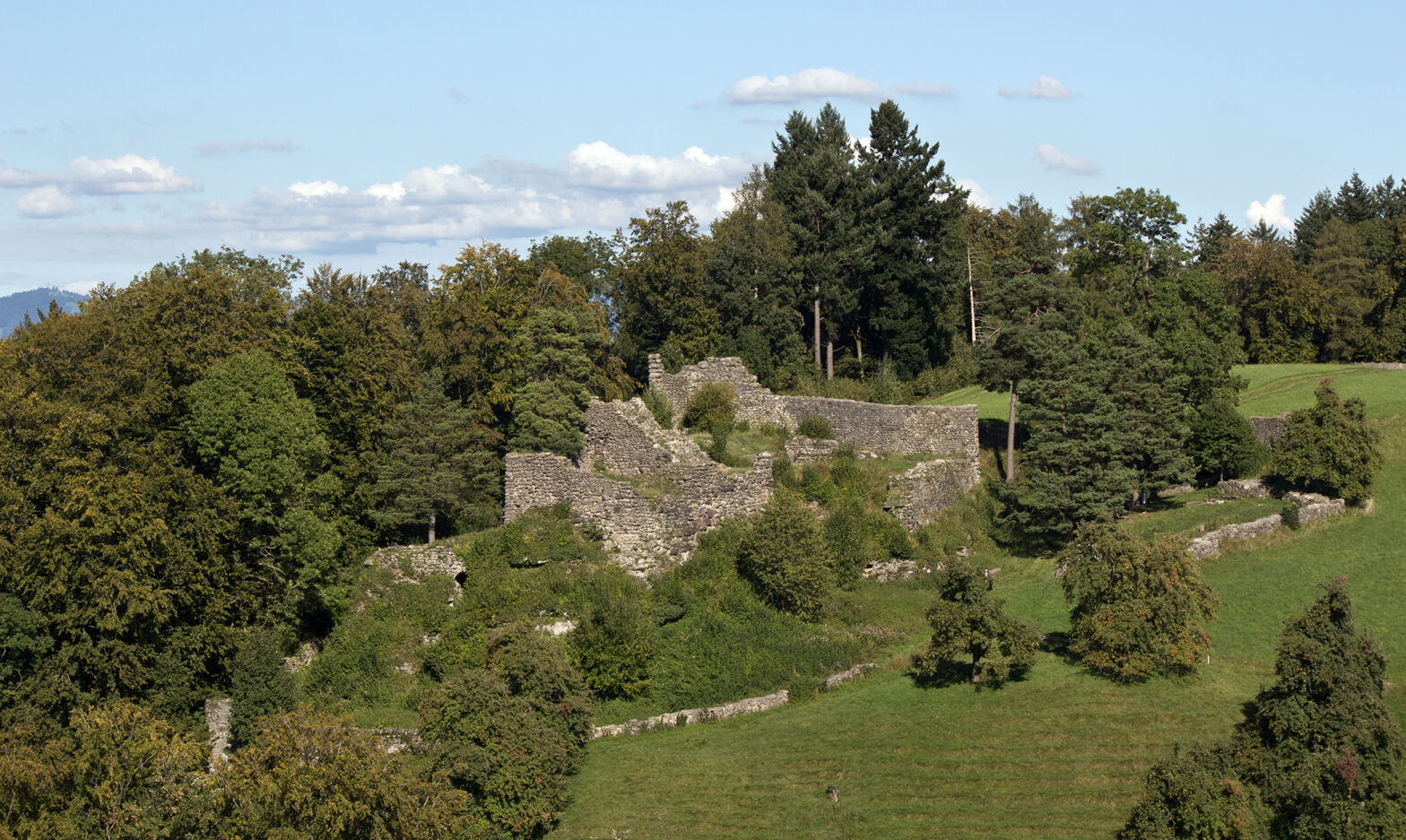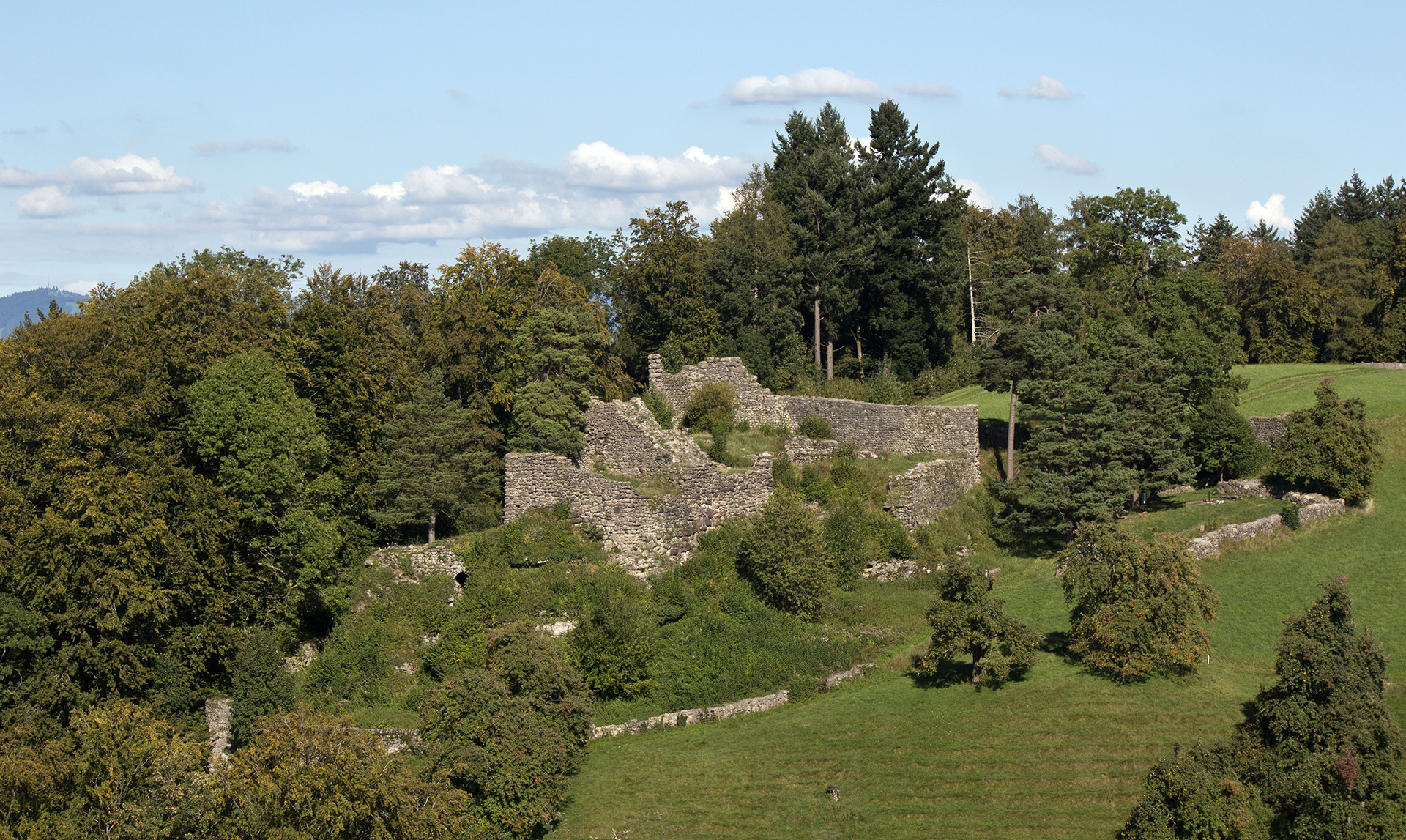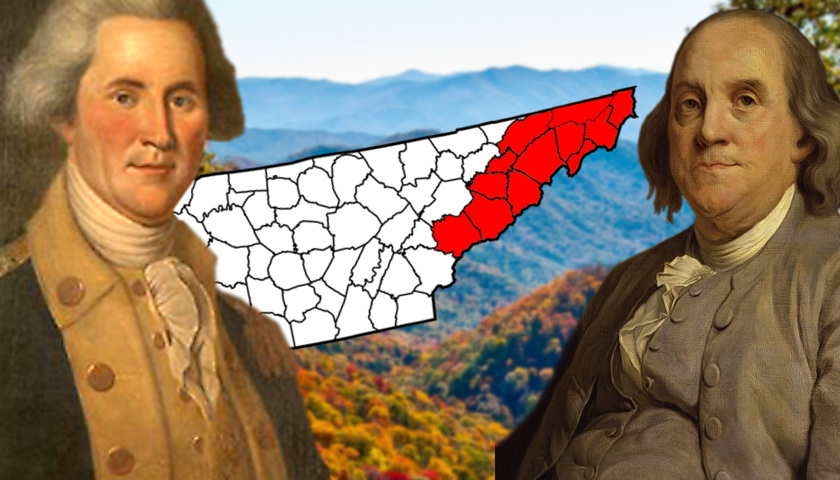24 – Daniel’s Son David Haston Cut Tails Off a Neighbor’s Cows

24 - David Haston Cut Tails Off a Neighbor's Horned Cows

Some of us Haston boys have been known for mischief. Just ask people who knew us while we were growing up. For example, out of a class of 212, the principal’s daughter I were voted “Most Mischievous” in my senior year of high school. I had worked hard to earn that honor. After all, David Haston was my GGG Grandfather. And you ought to hear some of my father’s tales of mischief.
I (double-dog) dare you to post some of your mischievous stories in our Facebook Group!
At age 20, David cut the tails off his neighbor’s cows and ended up in Knox County, TN court.
Have you ever had a cantankerous neighbor–one that everybody seemed to have trouble with? Nathaniel Hays (a Revolutionary War veteran) appears to have been that kind of person.
In 1797, there was no Lake Loudon below Knoxville. So the river (“Holston” at that time) was lower than now and in low-water seasons there were numerous islands up and down the river. But there was one island, very near where the Hastons lived, that was quite large (see the map image). This may have been the scene of “the crime.”

From the court records, here’s the re-enactment (best I can tell) of the mischievous deed that got David in trouble:
- Nathaniel Hays had horned cattle that grazed on the island.
- The fence that was supposed to keep the cows in their place was low and “not good” and the cows were not contained properly.
- Apparently, the cows got out (perhaps often) and created some kind of problem for the Daniel Haston family.
- So David cut the tails off of two of Mr. Hays’s horned cows. That will show him!
- Mr. Hays went across the river (December 18, 1797) and filed a complaint with James White, founder of Knoxville and a Justice of the Peace for Knox County.
- David was arrested and brought to court on April 11, 1798.
- Some witnesses were summoned to testify against David, including some Roddy children (siblings of David’s future wife, Margaret/Peggy Roddy).
- Some of the witnesses testified that they saw the bleeding cows and David was there at the scene.
- David was found “guilty” and fined $5.00. Joseph was found “not guilty.”
Who was Nathaniel Hays? He was granted land in Middle Tennessee because of his Revolutionary War service. He was temporarily living in Knox County until the Indian attacks ceased. Finally, in about 1804 or so he took up his Middle Tennessee land – it was adjacent to where Andrew Jackson lived. On June 7, 1809, Nathaniel Hays exchanged his land with Andrew Jackson’s land and Hays’s original tract became the site of Jackson’s home place – The Hermitage.
If you appreciated this article, please share it with others who might also enjoy it.

08 – The Amazing Richterswil Fountain

08 - The Amazing Richterswil Jet Fountain
Weather permitting and etc., we will watch the world famous Richterswil Jet Fountain “spout” on Sunday, June 25, 2023.

The Richterswil FONTÄNE, with its height of 101 meters (331 feet), takes eighth place among the top ten, but it is the highest fountain in the world that is operated with sheer gravity, therefore without a pump.
The Wet Attraction of Richterswil
Around 1875 the fountain near Richterswil splashed water into the sky for the first time – higher than any other in Europe. In 2007 the population celebrated the revitalized facility.
“Those from the other bank will be jealous,” says an older man. The man is convinced that the restored fountain in the lake at the Richterswil swimming pool arouses envy among the residents of Zurich’s Gold Coast. Hundreds of Richterswilers were happy with him on Saturday evening on the lakeshore about the fireworks, but there was only applause when the jet of water from the fountain that was put back into operation began to fight its way up into the sky. At first hesitantly, but then with a lot of energy, the jet of water shot up around 80 meters. At the beginning you could admire a straight fountain, but then the wind came up and the jet turned into a mist that made the audience dripping wet. But this did not detract from the mood. Some fled from the wet, others persevered – that was a nice memory of childhood. More

9:34 Video
Share this with Hastons or related family members who might be interested in the June 14-27, 2023 Hiestand-Haston European Heritage Tour.

Understanding Your DNA Results – Darvin Martin Zoom Meeting
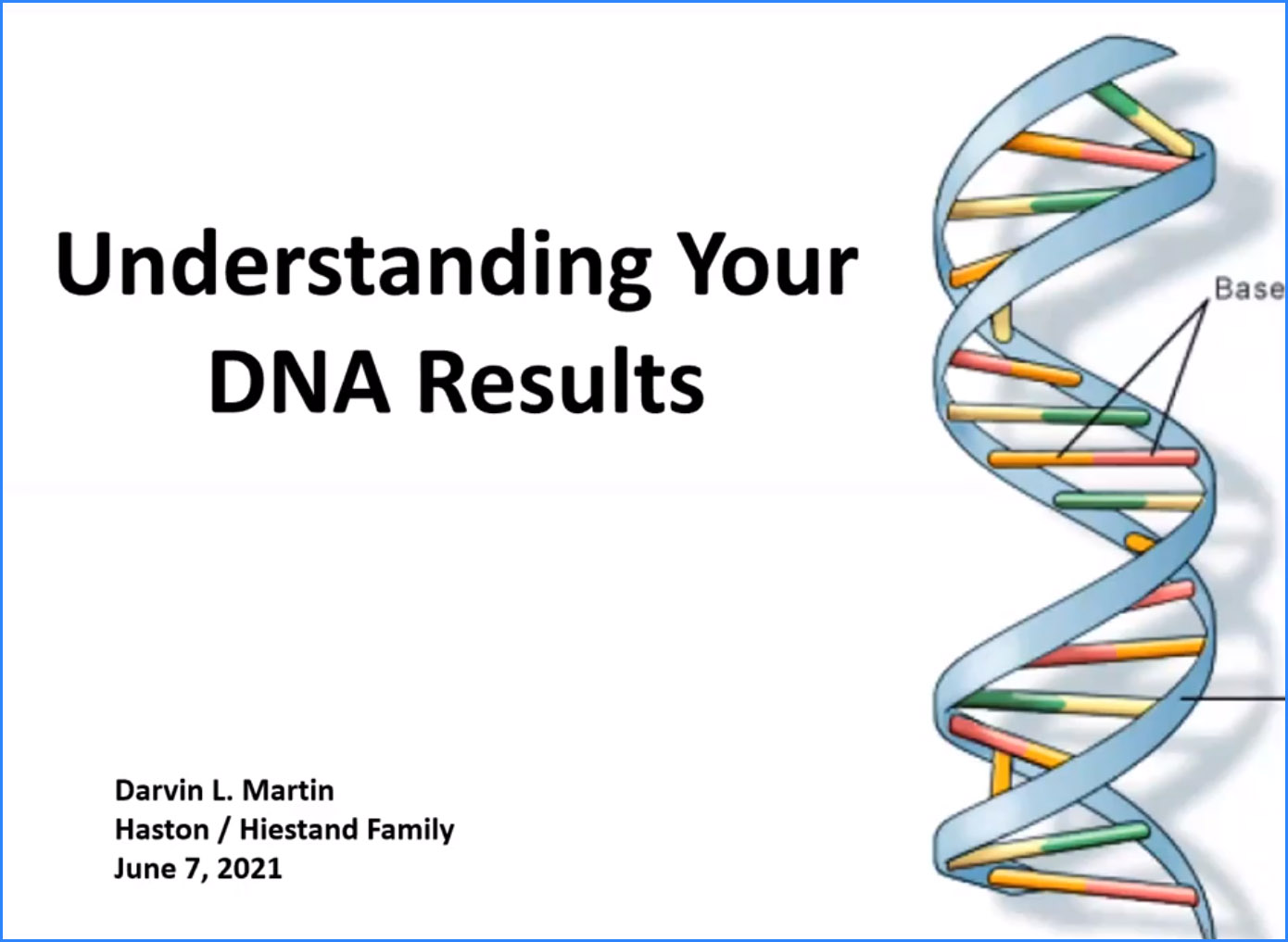
Understanding Your DNA Results
Darvin Martin in Our June 7, 2021 Zoom Meeting

Darvin Martin – an expert in Swiss-German Mennonite genetic (DNA) genealogy. Darvin presents a basic understanding of DNA as it relates to family research. But there is lots of time for questions and answers.
If you appreciated this article, please share it with others who might also enjoy it.

23 – Daniel Haston Family – South of Holston River, Opposite Knoxville, TN
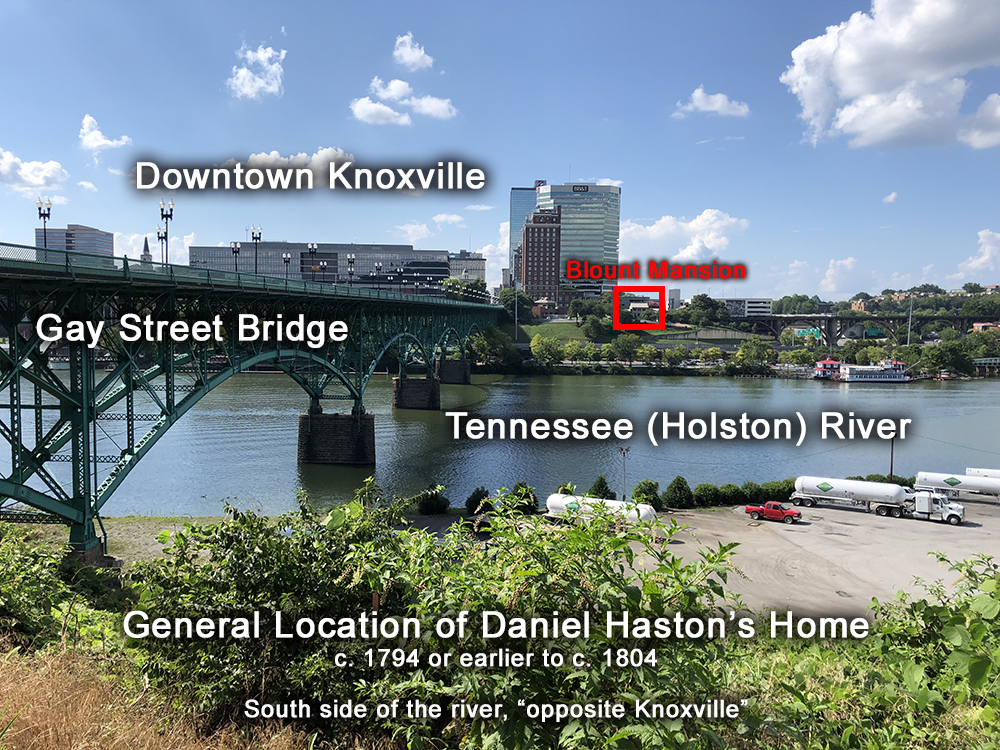
23 - Daniel Haston Family, South of the "Holston" River
Opposite Knoxville, TN

Daniel and family lived in the Knoxville, TN area for about 10 years. There is a lot of information available about his family during that time, so Chapter 14 in the BIG book I’m working on contains 70+ pages. I’ll extract some of those highlights in the next several articles.
Daniel’s family lived on a small lot south of the Tennessee river (or Lake Loudon), that was then called the Holston River. The lot was rented from James Charter. When Daniel arrived in Knoxville, it was a tiny frontier village (just a couple of years old) and “Tennessee” wasn’t even a state. That’s why you can become a member of First Families of Tennessee, if you can document your lineage back to Daniel.
Daniel didn’t live in the village of Knoxville. He rented a small lot across the “Holston” River (now, “Tennessee River” or “Lake Loudon”). Perhaps he couldn’t afford to live in the village, so where he lived may have been like a “slum” section for very poor people. Or maybe it provided more space for a garden, some pigs and a milk cow or two. Or maybe some of both reasons.
It was at the south end of the (now) Gay Street Bridge, but a ferry was the only way to cross the river in Daniel’s day. The area is now “South Knoxville.” And it’s just a half mile up and across the river from Neyland Stadium, home of the University of Tennessee Volunteers!


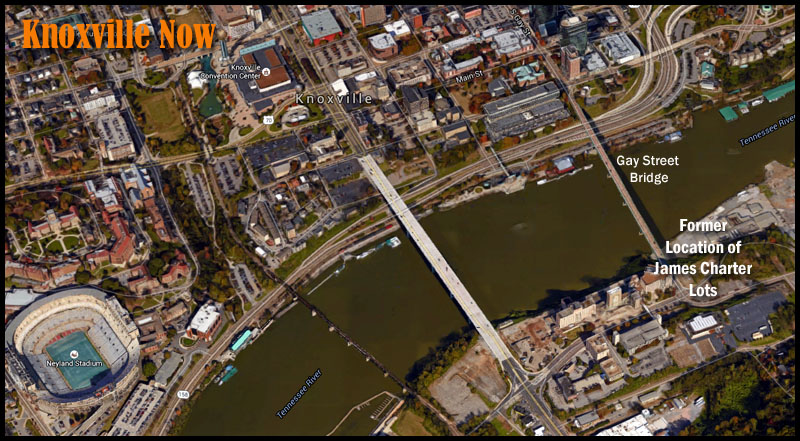
When the ceremonious events surrounding the famous Treaty of Holston with the Cherokee Indians were going on in 1791 – they were directly across from where the Hastons lived. Our Hastons would have had some of the best “seats” to observe the ceremony – except that they were probably not living there quite yet.
Daniel’s family lived directly across from the Blount Mansion, the capitol building for the U.S. Southwest Territory prior to Tennessee’s statehood. Governor William Blount could have seen the Haston’s humble cabin by looking out his window and across the river.
Significance of where the Hastons lived. Even though Daniel’s family lived was south of the river, it was a significant location. The ferry docked on the south bank very close to their house and from there one road went to what is now Sevierville, TN and another to Maryville, TN. So as the area developed, lots of people traveled by their home, including John Sevier, after he became Governor in 1796. Governor John Sevier passed the Hastons on his way to his farm, “Marble Springs.” Two entries in Governor John Sevier’s journal indicate he paid Mrs. Haiston $3.00 in full of all “accounts” (?) and Suza Haiston $1.00 for four melons. Were these two women the same people? Was Suza Haiston a wife of Daniel? Or, was Suza a daughter?
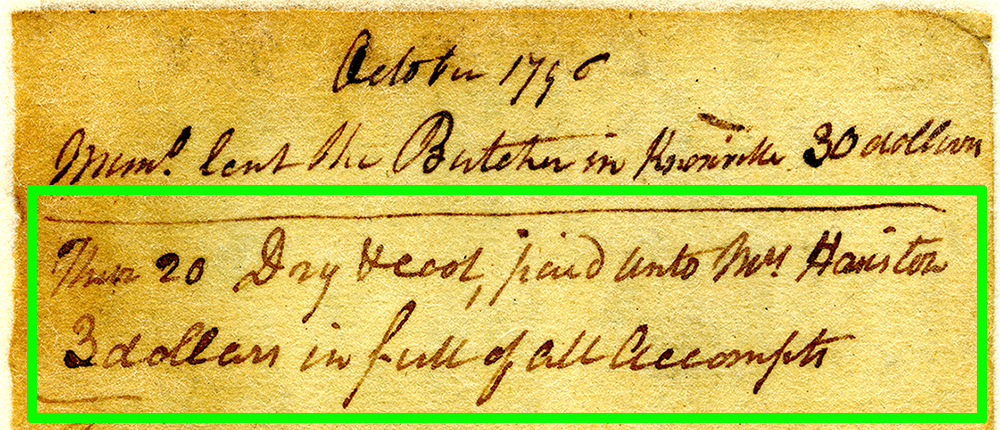
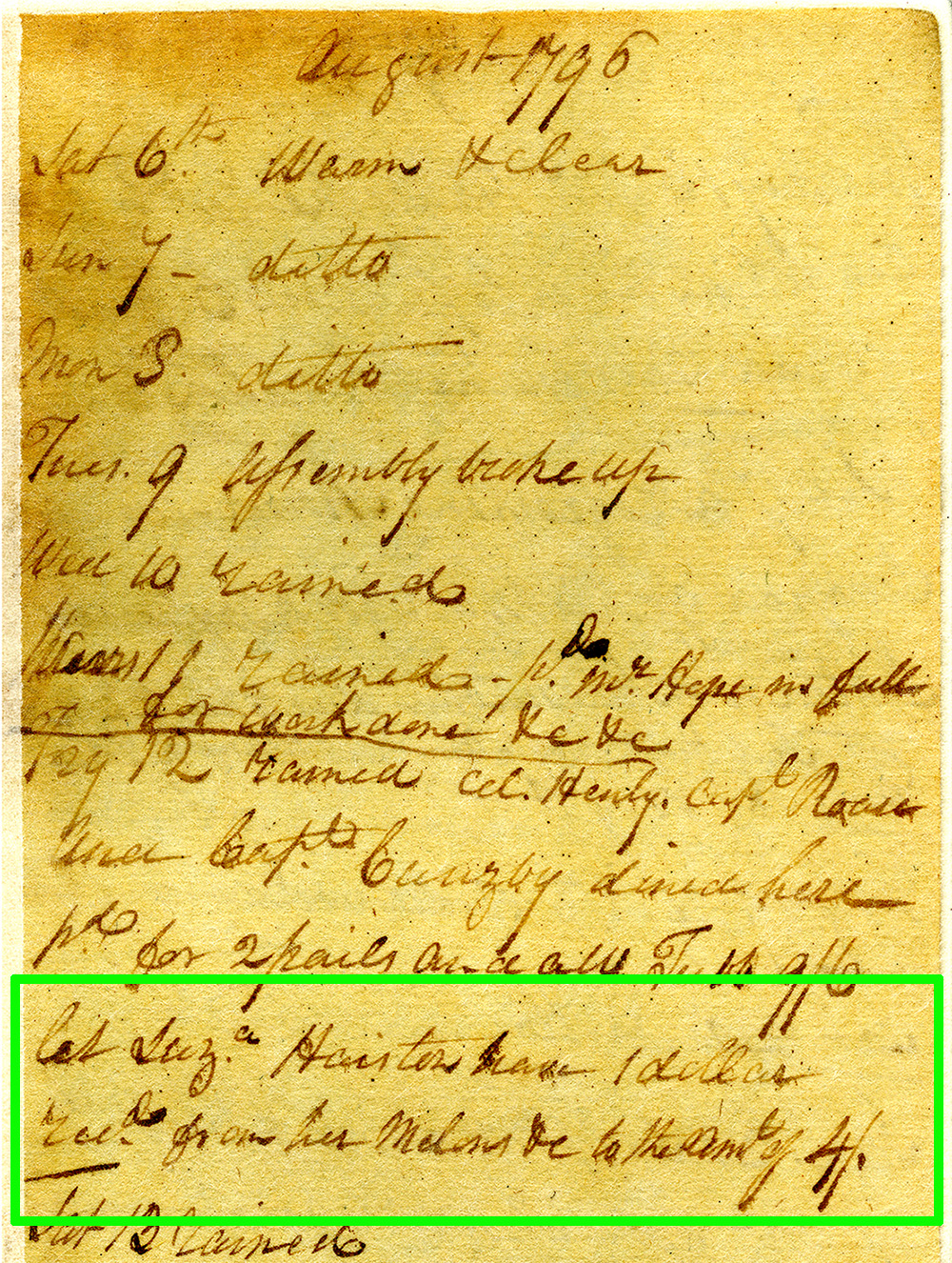
In the next few articles, I’m going to tell you a humorous story about one of Daniel’s sons who cut the tails off his neighbors cows – another son who tore down a fence and got in trouble – Daniel’s many appearances in court (but honorable appearances) – a marriage that has influenced many of our lives – where David Haston lived when he got married – and more interesting happenings. Stay tuned.
If you appreciated this article, please share it with others who might also enjoy it.

22- Two of Daniel Haston’s Siblings in South Central KY

Two of Daniel Haston's Siblings in South Central, KY


Abraham Hiestand's (Hestand's) Path Ends in South Central KY
John Mulkey and his brother Philip Mulkey, sons of Rev. Jonathan Mulkey, were members of the Big Pigeon Baptist Church near what is now Newport, Tennessee while Abraham Hiestand/Heaston and his family were members there. They served together in some church business assignments. In the fall of 1797, the Mulkeys left the Big Pigeon church and moved to what is now Monroe County in south-central Kentucky, where they planted the Mill Creek Baptist Church, near Tompkinsville, KY, as well as several other branch churches in that area.
A few months later, March 31, 1798, Abraham also moved to Kentucky. Prior to 1797, the area south of the Green River in KY was reserved for Virginia’s Revolutionary War veterans. But in 1797, anyone over 21 years old could claim land there. “Such persons were entitled to not less than 100 acres or more than 200 acres, but must have been bona fide settlers on the land for one year before they became into actual possession.”
Abraham staked his claim on 200 acres, but only had 100 acres surveyed. However, it was not near Mulkey’s church–it was on the Green River, about 40 miles north of Tompkinsville, KY.

Abraham's 100 Acres Survey on the Green River
This tract is near Campbellsville, KY in Taylor County. Notice the boundary with “Tibb’s Line.” In the Civil War the Battle of Tebb’s Bend was fought at that site. An adjacent bend in the Green River is known as Lemon’s Bend. It is named for John Lemon, a longtime acquaintance of Abraham.
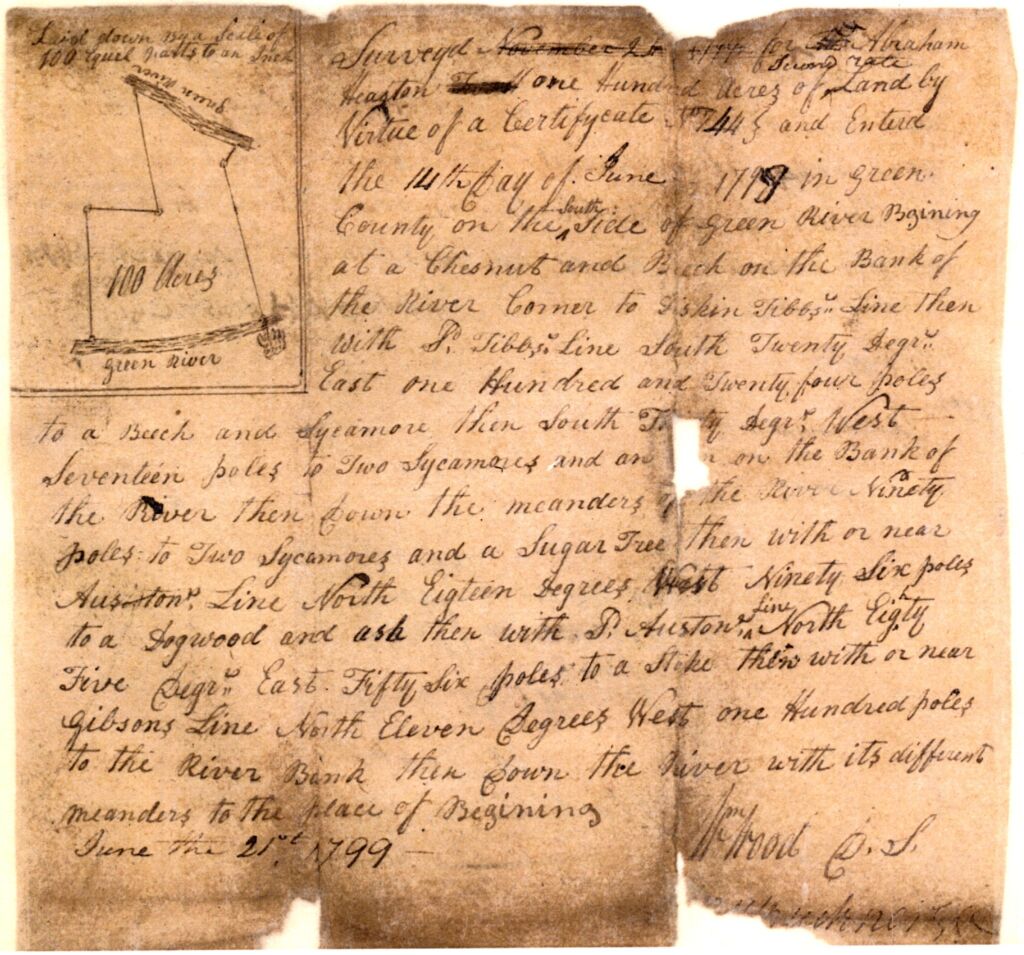
For some reasons, perhaps the death of his first wife, Abraham never finalized the claim to his 100 acres on Green River. Instead, he chose to live in Monroe County (actually, Barren County until 1820) and joined the Mill Creek Baptist Church.
The Mill Creek Church Split

The Mulkey brothers were sons of Jonathan Mulkey, a famous pioneer Baptist preacher in western North Carolina (East TN). But Pastor John began to develop some doctrinal views that concerned some members of the Mill Creek Baptist congregation. Those concerns escalated to the point that the church split on November 11, 1809.
It was while a representative number of the church were attending and a proposition was made that those who endorsed Mulkey’s doctrine were to walk through one of the doors of the building, and all who opposed the doctrine of Mulkey were to walk out the other door of the building. The proposition also was made to count the members who followed each deacon out and the deacon who had the largest number of members, he and his members were to retain the building. The count disclosed that those who favored John Mulkey drew a majority and thereby gained possession of the building.[i]
[i] Cawthorn and Warnell, 437.
John and Philip Mulkey went on to become prominent leaders in what became known as the Restoration Movement, which generally centered around the theology of Barton Stone and, later, Alexander Campbell.
The Baptist minority from the Mill Creek congregation who refused to follow Mulkey’s theological direction found themselves (literally) standing outside without a meeting house. “They proceeded to purchase one and one half acres of ground from John Harris, on which they erected a new “Mill Creek” building.
Out of which door did the Hestands exit? Subsequent records indicate that Abraham Hestand and, his son, Daniel Hestand remained faithful to the Baptist roots they had put down in Virginia and nurtured during their years in eastern Tennessee. They broke ranks from their old friend, John Mulkey, and joined the new Mill Creek Baptist Church.
Hestand, Kentucky
Abraham Hiestand’s family took root in South Central Kentucky. The Hiestand name became Hestand. And a community in southern Monroe County was named for them. A post office was established there in 1888.

Daniel's Youngest Sister and Brother-in-Law, the Gimlins
Andrew and Mary Magdalene Hiestand Gimlin Near Harrodsburg, Kentucky
Daniel’s little sister, Mary Magdalene Hiestand, married Andrew Gimlin on December 5, 1773. Less than three years later, Andrew was in Kentucky (which was a western territory of Virginia at the time) raising corn and building a cabin. Although the law was not enacted until 1779, apparently there were rumors of a “Corn Patch and Cabin Rights” law in the works in the Virginia legislature. The law stated: “Every settler who had occupied a tract and had raised a crop of corn [in Kentucky] before January 1, 1778, was entitled to 400 acres at the price of $2.25 per 100 acres and was allowed the further right to pre-empt an additional 1,000 acres at $40.00 per hundred acres.”[i]
[i] Willard Rouse Jillson, comp., The Kentucky Land Grants, Part 1. (Baltimore: Genealogical Publishing, 1991), 3-5.
Andrew certainly must have anticipated this law when he visited and planted corn there in the summer of 1776 (when the Declaration of Independence was signed!). Virginia Land Commission Records for 1779-1780 state:
Andrew Gumlin this day [January 28, 1780] claimed a settle’d and preemption to a tract of land in the District of Kentucky on acc’t of raising a crop of corn in the County in the year 1776 lying on the north side of Dicks (Dix) River about 1 miles E of James & Edmund Arches land to include his improvement. Satisfactory proof being made in the Court the commissioners are of the opinion that s’d Gimlin had a right to settlement on 400 acres of land to include the s’d improvements & and the preemption of 1000 acres of adjoining & that a Cert. Issue accordingly.[i]
[i] Kentucky Historical Society, Certificate Book of the Virginia Land Commission, 1779-1780. (Greenville, SC: Southern Historical Press, 1981), 151.
This was the Daniel Boone and James Harrod Era in Kentucky!
Andrew and Magdalena Gimlin were definitely the most adventuresome members of the Henry Hiestand family. Their area of central Kentucky was not safe from Indian attacks for another twenty-five years or so after they settled there. The Gimlins were entering the northern part of what Cherokee Chief Dragging Canoe predicted in March 1775 would be “a dark and bloody ground” if white settlers took their hunting grounds away from them. Chief Dragging Canoe’s prediction came to pass, just like he promised. Wisely, Andrew and Magdalena settled near Fort Harrod where they could flee for protection during impending Indian attacks.
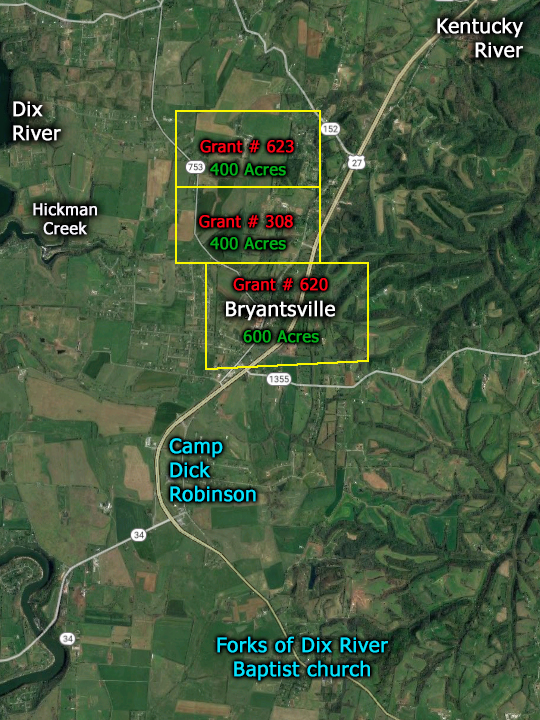
Andrew Gimlin’s first recorded appearance as an abiding settler in Kentucky was on January 28, 1780. Andrew probably arrived in Kentucky before the 1779-1780 winter and a few months later began to acquire the 1400 acres he was qualified to own because he had been there and raised a crop of corn and constructed some kind of shack in the summer of 1776. [i]
[i] Andrew Gimlin, Early Certificates of Settlement and Preemption Warrants in Kentucky County, Virginia. January 28, 1780.
Unfortunately, no stories of the Gimlin’s adventures while living between the Dix and Kentucky Rivers have been passed down to us. But enough has been recorded about life (and death!) in and around Fort Harrod (Harrodstown/Harrodsburg) and Fort Boonesborough (50 miles to the east) to inform us that Andrew Gimlin and his family must have suffered much during their 20-plus years there.
Boundary disputes and lawsuits, due to the poorly managed disbursements of grants and sloppy surveys soon plagued Andrew Gimblin and many of the other Kentucky settlers. Eventually, the Gimlins moved farther south to Cumberland County, Kentucky.
Where did they settle in Cumberland County, Kentucky? On the 1810 Federal Census for Cumberland County, Kentucky Samuel, David, and Molly Gimlin’s names appear on the same census roll as three of Abraham Hiestand’s sons: Abraham Hastings (Jr.), Henry Hastings, and Daniel Hastings. Molly’s name appears just 48 names above the Hastings cluster of names.[i] We know from other records that the Gimlins and these Hastings/Hestands lived in the southwestern corner of Cumberland County that became the southeastern corner of Monroe County, Kentucky in 1820. They did not live far apart and, no doubt, the two siblings of our Daniel Haston reconnected!
[i] Year: 1810; Census Place: Burksville, Cumberland, Kentucky; Roll: 9; Page: 176; Image: 00185; Family History Library Film: 0181354
Fort Harrod - Where the Gimlins Probably Fled in Indian Attacks
If you appreciated this article, please share it with others who might also enjoy it.

21 – Daniel Haston Votes in Favor of the State of Franklin
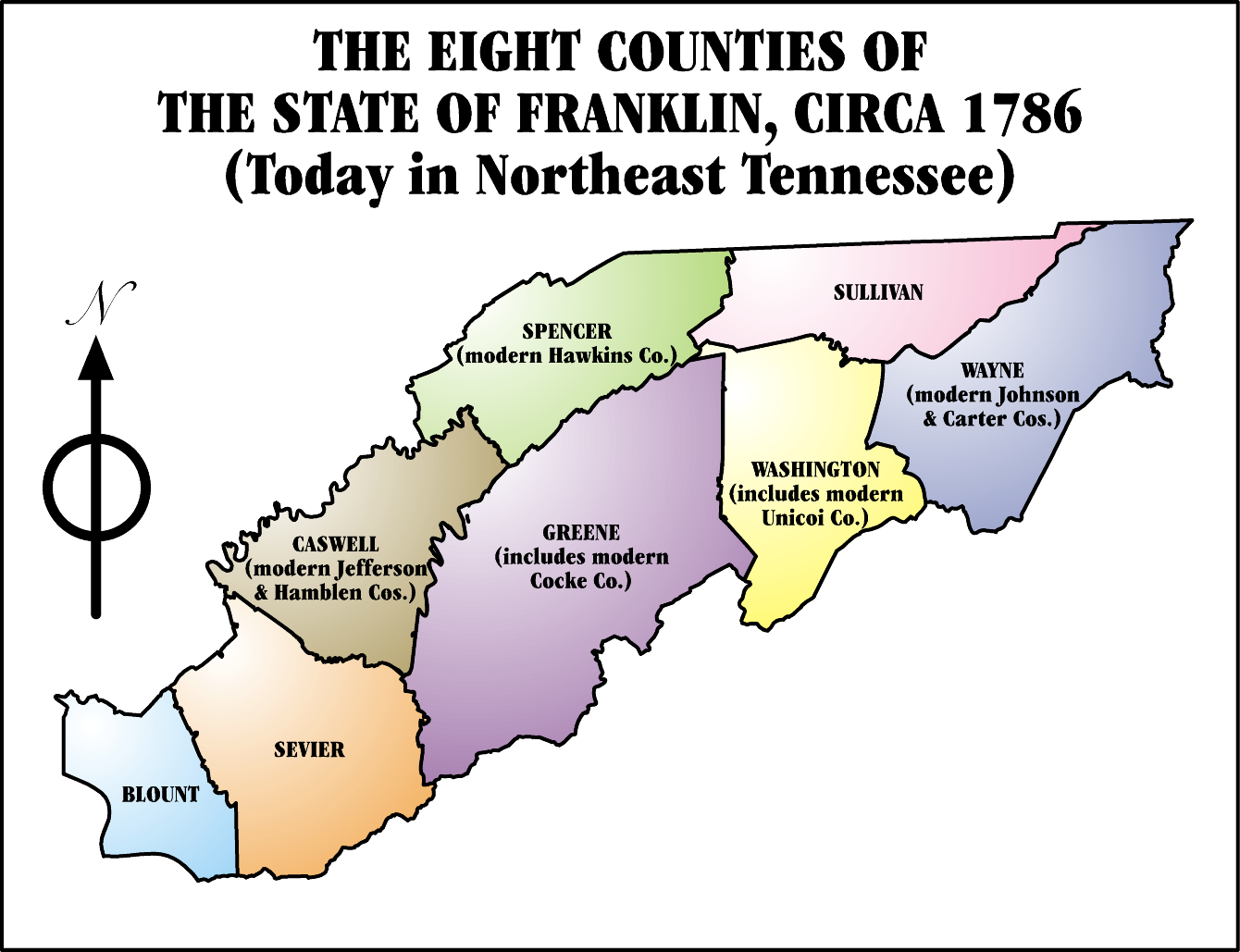
21 - Daniel Haston Voted in Favor of the State of Franklin
So, our Daniel was a "Franklinite"

The yellow county – Washington County – is where Abraham Hiestand lived for a few years. Although there is no (to my knowledge) evidence for Daniel Haston’s specific whereabouts in the county, apparently he also lived there for a few years. Both of them moved on after staying in the Washington County area for about a decade.
Before moving to his final home westward across the Cumberland Mountain into middle Tennessee, Daniel lived approximately twenty years in what we now know as East Tennessee. About ten of the first of those years were probably spent in or around Washington County (where Jonesborough was the county seat) and the next ten or so years in Knox County, near Knoxville. Abraham Hiestand, his family of dependents, and his adult children remained in east Tennessee until they moved to Kentucky in or about 1798. Abraham lived in at least two locations in east Tennessee, but we have no record of Abraham ever living in Knoxville or Knox County (although he may been jailed there at one point).
When Abraham and Daniel left the Shenandoah Valley, like many others before and behind them, they were “headed for the Carolinas”—ultimately western North Carolina, no doubt. Because of the Land Grab Act of 1783, there was plenty of good-but-cheap land west of North Carolina’s Appalachian mountains, but the act had a narrow window of time, from October 20 through May 25, 1784.[i] When the “office was opened at Hillsboro, October 20, 1783…the ‘vast crowd’ of people assembled there was so disorderly that the office had to be closed until October 23.”[ii] “During a seven-month period in [1783 and] 1784, the land office sold almost 4,000,000 acres at five dollars per hundred acres.”[iii] The North Carolina Assembly passed this act even though much of this land was “still in the possession of Native Americans.”[iv] The act violated all existing Indian treaties that were in effect to protect Indians living or hunting in the western wilderness of North Carolina. And, in the end, it was no surprise that three million of those acres “ended up in the names of North Carolina legislators or their business partners.”[v] So most commoners missed out on grabbing lots of good-land-cheap.
[i] Jonathan M. Atkins, “The Southwest Territory, 1790-1796,” in History of Washington County Tennessee, eds. Joyce and W. Eugene Cox (Jonesborough, TN: Washington County Historical Association, 2001), 75.
[ii] Albert Lincoln Bramlett, “North Carolina’s Western Lands.” (PhD dissertation, North Carolina University, 1928), 90.
[iii] Dave Foster, Franklin: The Stillborn State and the Sevier/Tipton Political Feud. (Johnson City, TN: The Overmountain Press, 1994), 2.
[iv] Atkins, 99.
[v] Atkins, 75.
Land may have been cheap and relatively plentiful in western Carolina, but trans-Appalachian living conditions were much more primitive and dangerous than back home in the northern neck of Virginia. Except for some areas damaged from fires caused by lightning, the terrain was almost entirely covered with trees. And the land was “almost impenetrable, even the barer spots were full of impediments such as briars and brush.”[i] Most of the few roads that did exist west of the mountains were little more than swaths hacked out through a wilderness following old Buffalo trails (“traces”) and Indian war paths. Farm fields required clearing of rugged virgin forests. Courts were inadequate to handle the demands of frontier justice. Schools were almost non-existent. “Danger lurked at every turn. The forest teemed with wolves, panthers, bears, rattlesnakes, and copper heads.”[ii] And Indian raids on white settlements and lone cabins were a constant threat and frequent reality.
[i] Watauga Association of Genealogists, History of Washington County Tennessee, 1988. (Johnson City, TN: Watauga Association of Genealogists, 1988), 8. Note: 1988 book, not the 2001 book.
[ii] Watauga Association of Genealogists, 8.
The brave denizens who lived on the wilderness side of the Appalachian Mountains were taxed by North Carolina at the same rate as wealthy plantation owners in the eastern part of the state, but received virtually nothing in return for their tax dollars.[i] North Carolina’s bankrupt post-Revolution “government” provided very little in the way of government for its western settlers—no significant development of roads, no schools, weak law enforcement, inadequate courts, and no protection from Indian incursions. By the time Abraham and Daniel settled in east Tennessee, many of the residents there were already clamoring for the kind of benefits state governments were expected to provide for their citizens. And it wasn’t long until clamoring turned into action, drastic action that led to a failed attempt for separate statehood.
[i] Foster, 2.
One minute video
State of Franklin
December 14, 1784 to March 1, 1788
On June 2, 1784, after several requests by the Continental Congress, North Carolina finally agreed to cede its western lands to the newly established United States and gave the Congress one year to accept the offer.[i] The proffer of cession was in a sense an “empty gift,” because of the “Land Grab” of October 20, 1783 through May 25, 1784.[ii] North Carolina had just “pocketed” revenue from the sale of four million acres of its most valued western lands and the offer to the United States by North Carolina required that previous land deals be allowed to remain valid.
[i] Robert E. Corlew, Tennessee: A Short History, Second Edition. (Knoxville, TN: The University of Tennessee Press, 1981), 73.
[ii] Atkins, 76.
When western Carolinians learned of the Cession Act, they were generally hopeful that the Continental Congress would provide the much needed help that North Carolina had failed to give. But they were temporarily left “without any form of government and with land offices closed” and “it was rumored that it might be two years before the federal government would accept the cession, leaving the area without protection and support from any government.”[i]
[i] Rae, 16.

In quick response to the cession, on August 23, 1784 some prominent North Carolina citizens from Washington, Sullivan, and Greene counties (forty delegates in all) met at Jonesborough in Washington County to consider whether or not to create a new state, independent of their eastern mother state. But in November of that same year, just five months after the Cession Act (and two months after the Jonesborough meeting), North Carolina rescinded its offer before the United States Congress in Philadelphia could respond to the Cession Act.
North Carolina’s reversal did not put an end to the western leaders’ pursuit of a new state. The group met again in November, but that meeting broke up in confusion and a lack of consensus regarding the plan for a new government.[i] However, the leaders of the new-state movement met a third time in Jonesborough on December 14, 1784 and voted, 28 “yea” to 15 “nay,” to “form a new and distinct state independent of North Carolina.”[ii] “A member of the convention from the door of the rude courthouse announced the result to the large crowd that had been drawn to Jonesborough, and the proclamation was received with joyful acclaim.”[iii] There’s a strong possibility that Daniel Hiestand may have been in this crowd that assembled in the street of Jonesborough.
[i] Samuel Cole Williams, History of the Lost State of Franklin. (1924; second edition reprinted, Johnson City, TN: The Overmountain Press, 1993), 33.
[ii] Foster, 3.
[iii] Williams, History of the Lost State of Franklin, 41.
Two Shenandoah Valley, VA Men Take Opposing Leadership Positions
Two Shenandoah Valley transplants to eastern Tennessee took opposing positions in the decision and became bitter adversarial leaders throughout the next few years. Both of these men were from the general area of the Shenandoah Valley of Virginia where our Hiestand family lived! Colonel John Sevier had gained fame as an Indian fighter and key leader of the Overmountain Men who defeated the British and Tories on October 7, 1780 at the Battle of King’s Mountain. Sevier was born and grew up west of the Massanutten Mountain from the Henry Hiestand family and is credited with developing the town of New Market, Virginia before moving to the Carolinas. Sevier was a “yea” voter in the December Jonesborough meeting. Colonel John Tipton, a former Shenandoah County, Virginia militia leader, justice of the peace, sheriff, and member of the Virginia House of Delegates, voted “nay.”
In March 1785, the new state was officially organized and John Sevier was elected to be the state’s first governor. The initial choice of a name for the state was “Frankland,” meaning “Free Land.” But in an effort to gain the support of Benjamin Franklin, an American hero whom they hoped would help them become accepted into the United States, the state’s name morphed to “Franklin.” But Benjamin Franklin would have no part in supporting the proposed state. Four new counties were established within Franklin: Wayne, Spencer, Caswell, and Sevier. In August of 1785, the Franklin legislature chose the more centrally located town of Greeneville in Greene County as its capital, rather than Jonesborough. In response to the birth of Franklin, “John Tipton erected a powerful anti-statehood movement seeking to destroy the state of Franklin and elevate himself and his supporters into positions of political prominence.”[i]
[i] Barksdale, 60.
Daniel Heston's Vote for Pro-Franklin Candidates
On August 18, 1786, Daniel Heston voted for pro-Franklin candidates in an election conducted in Jonesborough on the third Friday and Saturday of August 1786. Daniel Haston’s vote at the Jonesborough polling site indicates that he was pro-Sevier and pro-Franklin, at least at the time of the August 1786 election. Anti-Franklin voters set up their polling place in a cave on John Tipton’s farm near Johnson City, TN. His brother, Abraham, apparently did not vote at either location.

Franklin’s leaders were unable to gain support for statehood from North Carolina, as well as the power brokers in Washington. So even though the Franklinites out-polled John Tipton and the Anti-Franklinites in the August 1786 election, their drive for United States statehood was not achieved at that time. But ALL of what had been Western Carolina would become the State of Tennessee ten years later, June 1, 1796.
Funny and Historically Informative Video
If you appreciated this article, please share it with others who might also enjoy it.

07 – Richterswil – Our Swiss “Hometown”
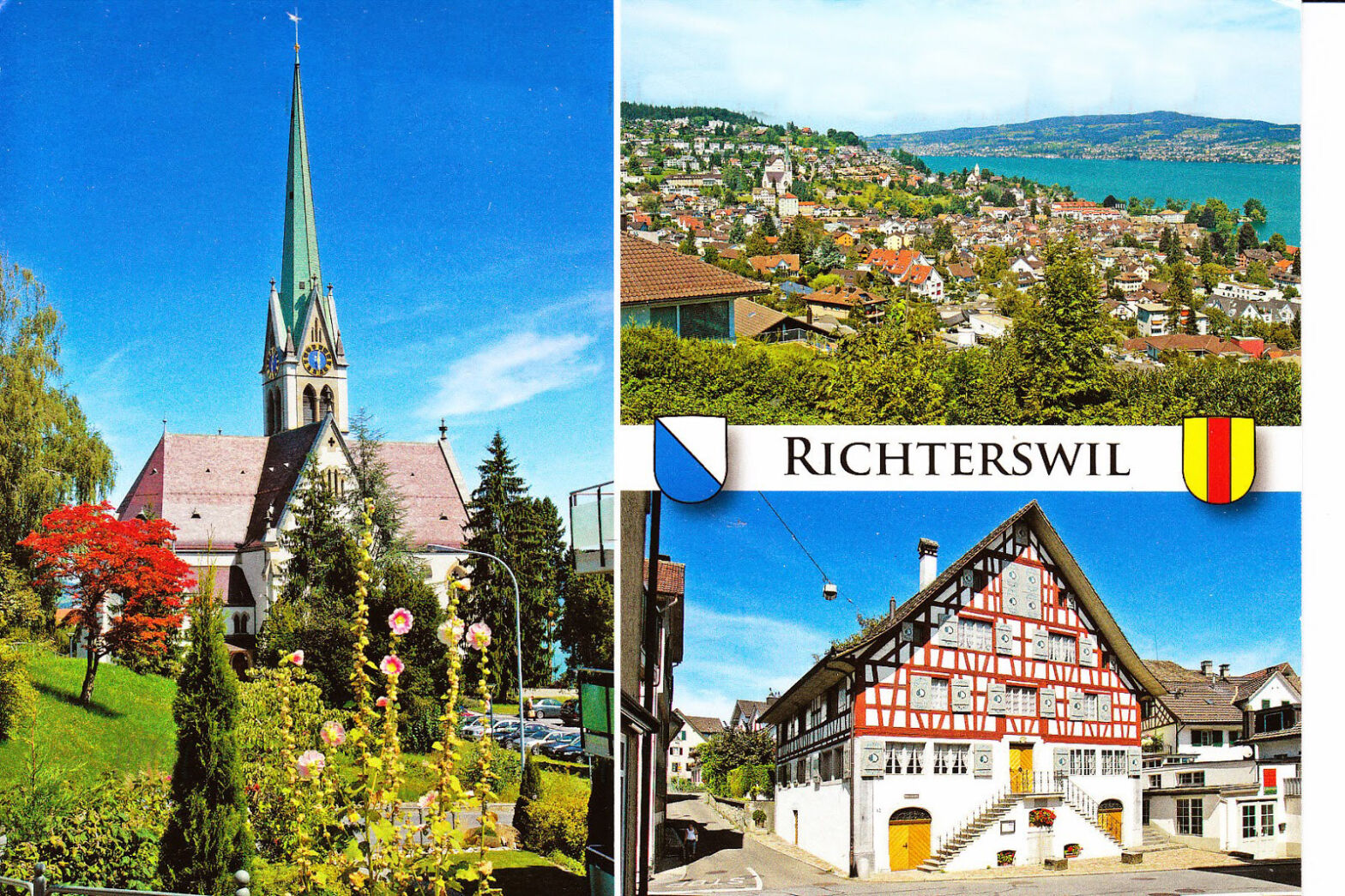
07 - Richterswil, the "Village" of Our Swiss Hiestands
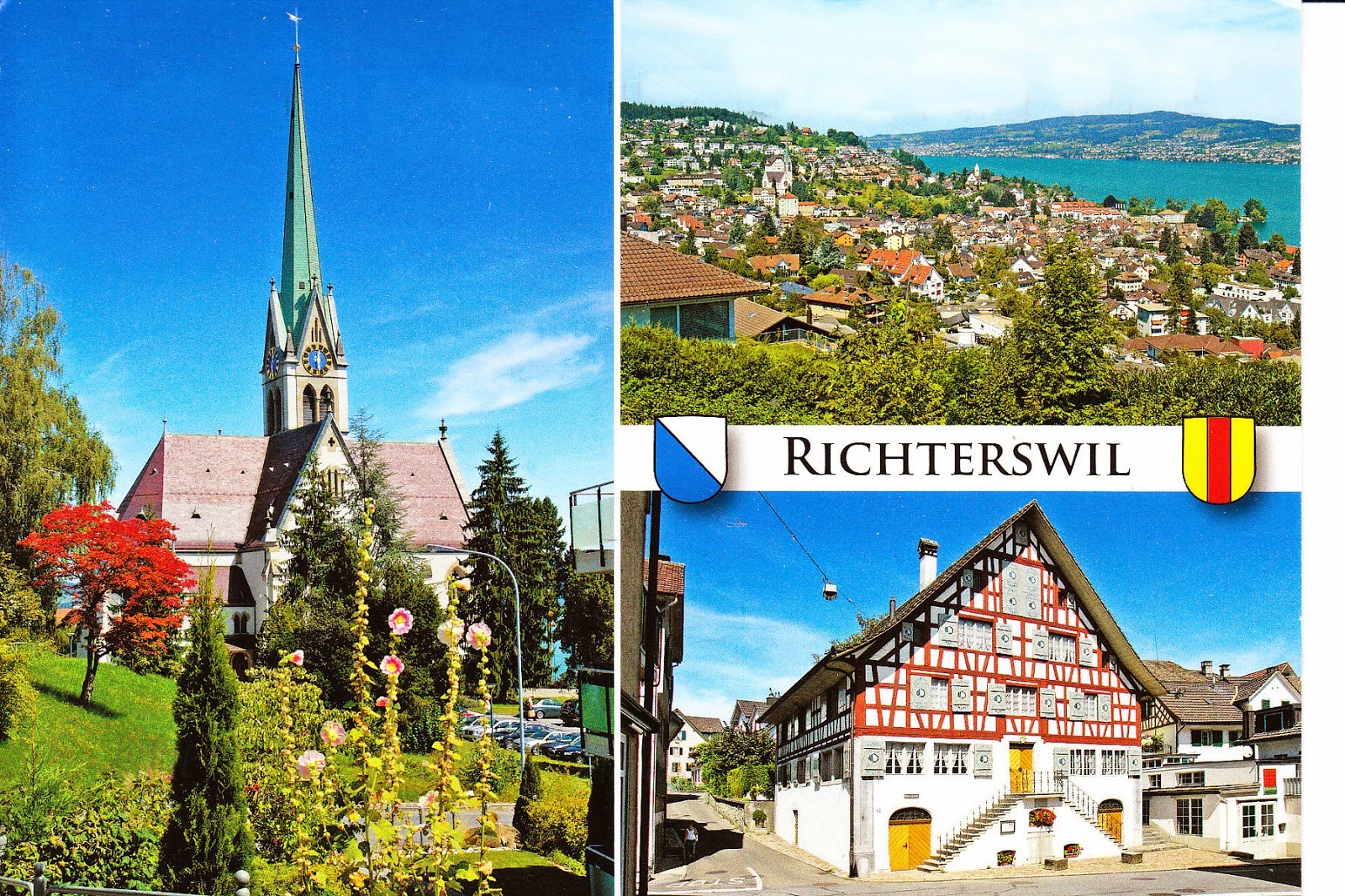
Although our Hiestand ancestors lived in other villages around Lake Zürich, we can probably think of Richterswil as our Swiss hometown. For that reason, we will be spending four nights in Richterswil, where – in our free times – we can walk the streets that our ancestors walked, visit the lake front, grab a snack in a café, and browse (and spend our Swiss francs) in the shops of the town.
By special request, we have arranged to make Richterswil the center of our tour for four nights.
Share this with Hastons or related family members who might be interested in the June 14-27, 2023 Hiestand-Haston European Heritage Tour.

05 – Zürich – Walking Tour of the City

05 - Zürich - A Walking Tour of the City
On the afternoon of Saturday, June 17, 2023, we will tour the city of Zurich, the largest city in Switzerland. It’s one of the most important financial centers in the world. Situated on the north shore of Lake Zurich and spanning the Limmat River, it is rich in history going back into the Roman era. But for those of us who descend from Swiss Anabaptists, the sites where key events in the Swiss Reformation and Anabaptist Radical Reformation occurred will be of special interest.
Two of the highlights will be the Protestant Grossmunster Church and the Fraumunster Church.

The Grossmünster (German pronunciation: [ɡʁoːsˈmʏnstɐ]; “great minster”) is a Romanesque-style Protestant church in Zürich, Switzerland. Huldrych Zwingli initiated the Swiss-German Reformation in Switzerland from his pastoral office at the Grossmünster, starting in 1520. Zwingli won a series of debates presided over by the magistrate in 1523 which ultimately led local civil authorities to sanction the severance of the church from the Catholic Church. The reforms initiated by Zwingli and continued by his successor, Heinrich Bullinger, account for the plain interior of the church. The iconoclastic reformers removed the organ and religious statuary in 1524. These changes, accompanied by abandonment of Lent, replacement of the Mass, disavowal of celibacy, eating meat on fast days, replacement of the lectionary with a seven-year New Testament cycle, a ban on church music, and other significant reforms make this church one of the most important sites in the history of the reformation and the birthplace of the Swiss-German reformation. Source: Wikipedia
It was also here that some of Zwingli’s young Bible students parted ways with Zwingli because they felt he compromised some of the New Testament principles he had taught them and didn’t go far enough in his attempt to reform the church to its original New Testament pattern. These young men became the leaders of the Anabaptist movement in Switzerland.
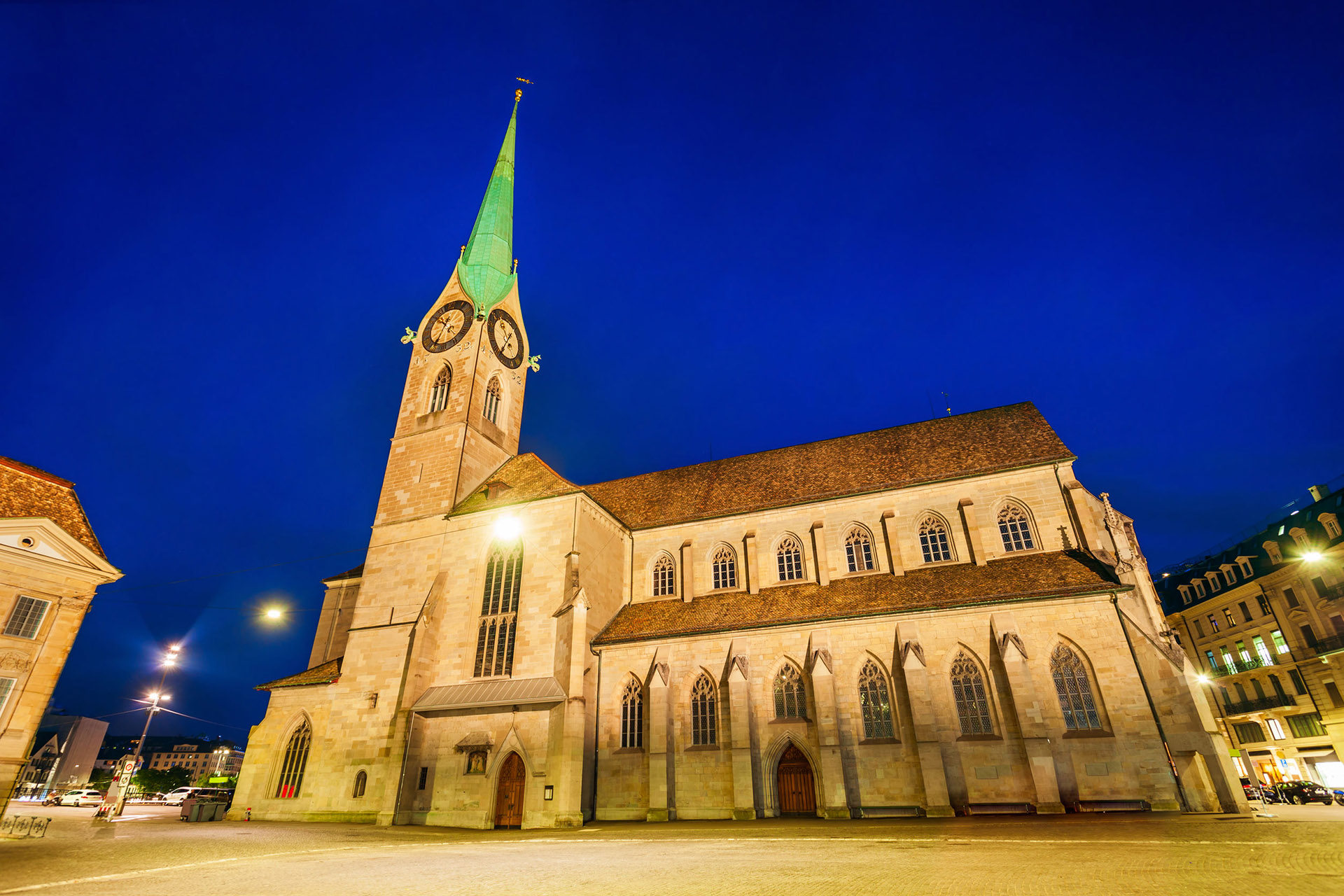
The Fraumünster (German pronunciation: [fʁaʊ̯ˈmʏnstɐ]; lit. in English: Women’s Minster, but often wrongly translated to [Our] Lady Minster) is a church in Zürich which was built on the remains of a former abbey for aristocratic women which was founded in 853 by Louis the German for his daughter Hildegard. He endowed the Benedictine convent with the lands of Zürich, Uri, and the Albis forest, and granted the convent immunity, placing it under his direct authority. Today, it belongs to the Evangelical Reformed Church of the canton of Zürich and is one of the four main churches of Zürich, the others being the Grossmünster, Prediger and St. Peter’s churches. The choir of the abbey includes 5 large stained glass windows designed by artist Marc Chagall and installed in 1970. Each of the 5 has a dominant color and depicts a Biblical story. Source: Wikipedia
Share this with Hastons or related family members who might be interested in the June 14-27, 2023 Hiestand-Haston European Heritage Tour.

20 – Abraham and Daniel Hiestand in the “Overmountain” Wilderness of NC
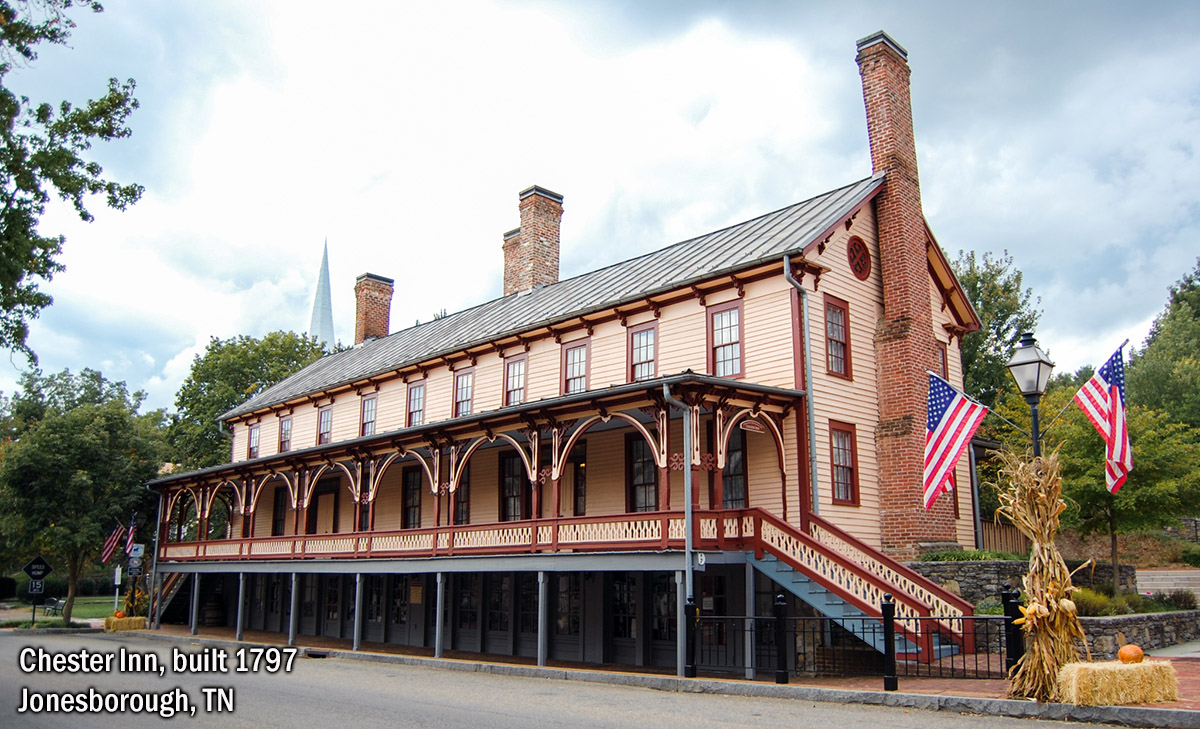
20 - Abraham and Daniel in the "Overmountain" of NC

For approximately 10 to 15 years, Henry Hiestand’s “boys”–Daniel and his older brother Abraham–lived in the “Overmountain” region of Western North Carolina. Well, that’s not totally accurate because that area became part of the 16th state of the USA, Tennessee (1796), while they were living there. Initially western North Carolina was a wilderness–a wilderness contested by Cherokee Indians. Jonesborough was founded in 1779, 17 years before Tennessee became a state and about four years before Abraham and Daniel moved there. The specific location where Daniel lived in Washington County is unknown, but we know that Abraham purchased land on Cherokee Creek, just a few miles south of Jonesborough. Daniel, apparently, did not own property there and pretty much lived “under the radar” in Washington County–except for one key event I will present in the next chapter.
Two of Abraham Hiestand’s Tracts of Land in Washington County


Brief Historical Overview of Now-Upper East Tennessee
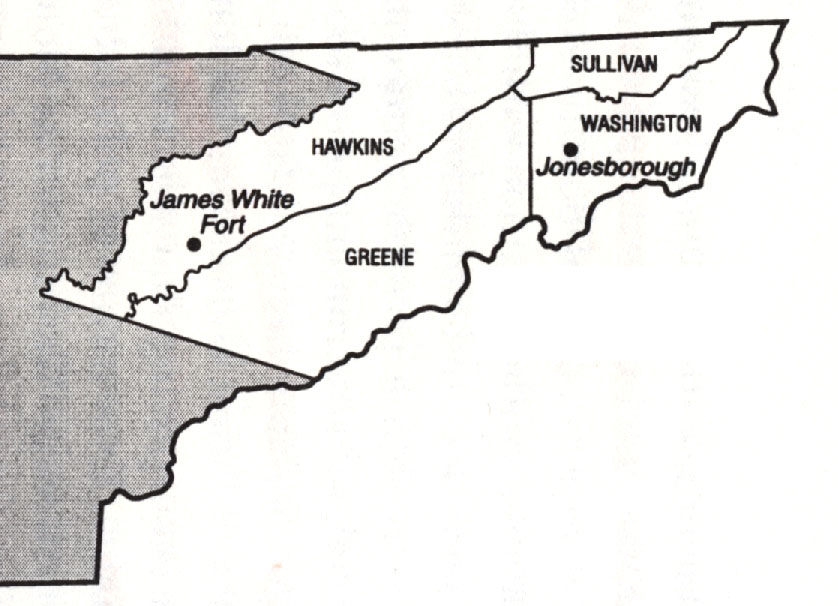
By May 1772 there were enough brave settlers living in North Carolina’s non-governed western wilderness (upper east of now-Tennessee) to form a quasi-government they called the Watauga Association. The Association was needed to manage land affairs, establish a frontier court, and band the folks together for protection against Native American attacks. “On July 5, 1776, the Watauga settlers sent a formal petition to the North Carolina General Assembly requesting to be annexed and organized into a frontier district or county. In April 1777, North Carolina accepted their petition…and established the Washington District,”[i] the first geographical area named for George Washington.
[i] Kevin T. Barksdale, The Lost State of Franklin: America’s First Secession. (Lexington, KY: The University Press of Kentucky, 2009), 21.
The Washington District became Washington County seven months later and included “all of present day Tennessee except for” some settlements that were thought to belong to Virginia at that time.[i] As settlers continued to pour in and the population of Washington County grew, Sullivan County was split (mostly) off Washington in 1779 and Greene County was formed from Washington in 1783. In 1787, Hawkins County was created out of Sullivan County. Until 1790, all four of these counties were in western North Carolina.
[i] Loraine Rae, Washington County, Tennessee: Deeds, 1775-1800. (Greenville, SC: Southern Historical Press, 1991), 11.
Brothers Abraham and Daniel Hiestand moved away from Powell’s Fort Valley in Shenandoah County, Virginia, with their families, sometime in 1783, or maybe even before then. Daniel may have travelled through the Piedmont region of North Carolina and sojourned there for a short time, but there is no hard evidence to prove or disprove that speculation. What we do know is that Abraham served on a jury in Washington County, Tennessee on July 15, 1783 and Daniel cast a ballot at Jonesborough in Washington County during the third week of August 1786.
Political Changes
Before Abraham and Daniel left what we now know as East Tennessee, there were several major political changes. “East Tennessee” was a part of the…
- State of North Carolina until December 14, 1784
- State of Franklin, from December 14 to March 1, 1788 (more about the State of Franklin in the next article)
- State of North Carolina (again, but briefly), from March 1, 1788 to May 25, 1790
- Southwest Territory of the United States, from May 26, 1790 to May 31, 1796
- State of Tennessee, from June 1, 1796 and on
I’ll have more to say about some of these in the next article.
Indian Conflicts
Pioneering white families endured fears of being scalped alive or brutally tortured or killed, fears of being taken captive perhaps never to return to their families, fears of rape or watching their wives and daughters raped, fears of witnessing their infant children or other loved ones “brained”—their brains bashed out by tomahawks or heads being slammed against a rock or tree. In his 1823 The Civil and Political History of the State of Tennessee, John Haywood, known as “the Father of Tennessee History,” summed this scenario up in these words: “Indian visitations assailed them incessantly. The settlers on the Holston at last seemed to hold their lives only by the permission and at the will of the Cherokees.”[i] But we must keep in mind that those Native Americans were fighting for lands they had owned and hunted in for centuries.
[i] Haywood, 150.
For the first ten years our Hiestands lived in eastern Tennessee, the feared tomahawk was never far away from them and was certainly not safely buried as it had been earlier where they came from in the Shenandoah Valley of Virginia. We who are descendants of Abraham or Daniel Hiestand should never forget the treacherous “bloody” wilderness they entered and the determination they had to push through it in order to reach a destination where they could settle down, eke out a living, and raise their families—our Hestand or Haston ancestors.
The Tales of Two Early Baptist Churches
The most helpful set of early and surviving east Tennessee records for the Hiestands (especially Abraham’s family) are minutes from business meetings of two Baptist churches, the Cherokee Creek Baptist Church in Washington County, near Jonesborough, and the Big Pigeon Baptist Church in what is now Cocke County, near the town of Newport. Fortunately for us, those records have remained intact to this day and have been preserved on microfilms and in printed transcriptions.
Cherokee Creek Baptist Church in Washington County, TN

Some of the early settlers in the Cherokee Creek area of Washington County began meeting for services in about 1780, very soon after they arrived there. On April 2, 1783, the Reverend William Murphy was installed as pastor of the Cherokee flock, marking the first recorded meeting of the congregation. On the first Saturday in September (September 6) 1783, founding members signed the church covenant and officially constituted the group as a church. The church was originally named “Baptist Church of Christ at Cherokee.
Abraham, and his wife Magdelena, were founding members of this church. But our Daniel and his wife were not founding members. In fact, the only Daniel Haston who was an early member of the church was probably Abraham’s son, Daniel.
Cherokee Baptist Church is the oldest continuous Baptist church in the state of Tennessee.

Big Pigeon Baptist Church in what is now Cocke County, TN
The Big Pigeon Baptist Church was located about 50 miles southwest of Jonesborough of Washington County–about half way between Jonesborough and Knoxville. In 1792 Abraham moved his family in that direction and became active members of this primitive Baptist Church.
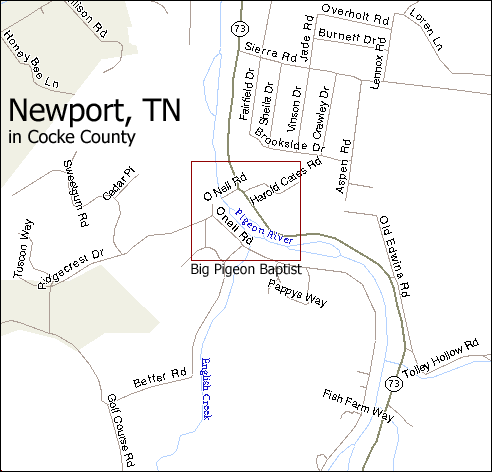
In spite of knowing the risks involved, white settlers continued to push deeper south toward and into Cherokee Indian territory. One such group consisted of Baptists. “In the latter part of the year 1785, and in the spring of 1786” a settlement on the Big Pigeon River in what is now Cocke County, Tennessee “was visited by Jonathan Mulkey and William Reno, Primitive Baptist preachers.” As a result of those meetings, William Whitson and Abraham McKay were chosen to represent the Big Pigeon Baptists at the 1786 Holston Baptist Association meeting to petition for “permission and the assistance of two ministers to establish a Primitive Baptist church” in their community. “Accordingly, on the 6th day of December 1787, the Rev. (Elder) Isaac Reno, and others met at the house of James English on Big Pigeon River and constituted, as they expressed it, the Primitive Baptist Society on Big Pigeon River.”[i]
[i] W.J. McSween, “Early Recollections of Newport and Cocke County,” Newport Times, 1903. Accessed, June 5, 2019, http://www.pblib.org/FamHist-CockeTN.html.
Initially, the Big Pigeon congregation consisted largely of members who transplanted from the same area of the Shenandoah Valley of Virginia as our Hiestands. At least half of the founding members of this primitive Baptist church were from Shenandoah County. Both churches – Cherokee Creek Baptist and Big Pigeon Baptist – had connections back to the Mill Creek Baptist Church of Virginia that was located near the Henry Hiestand farm. These two Tennessee churches seem to have considered the Shenandoah (now Page) County, VA church as their “mother church.”
On June 15, 1792, Abrm. Heaston, Sr. joined the Big Pigeon Baptist Church. Magdelean Heaston, presumably Abraham’s wife, had joined by letter three months earlier, March 10, 1792. For the next six years, Abraham was involved in some lay-leadership roles in the Big Pigeon Baptist Church.
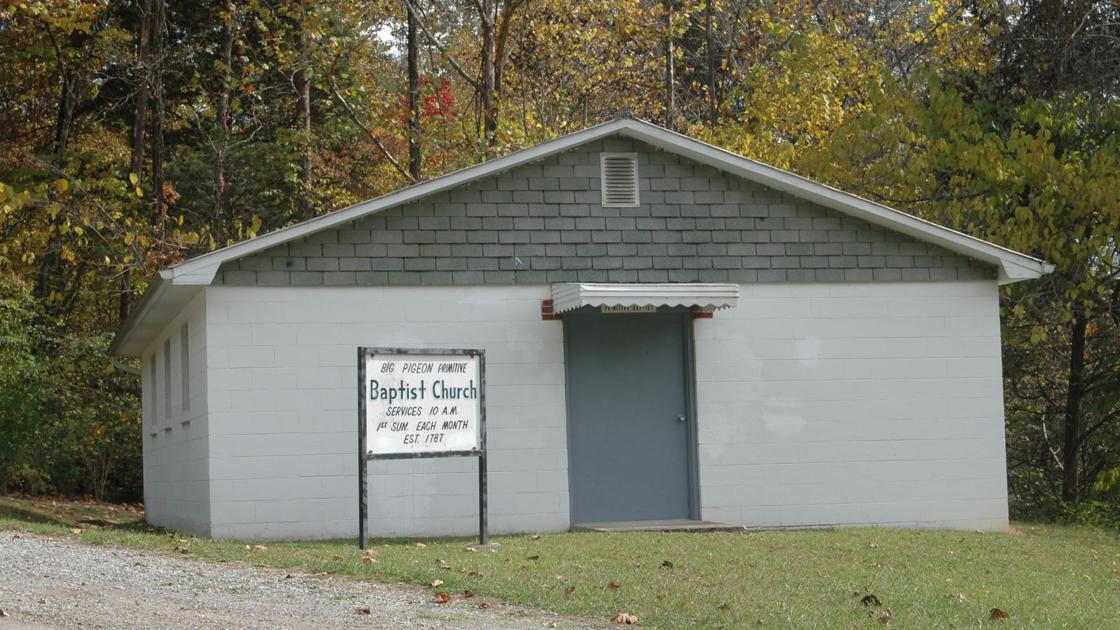
Thankfully, records for both of these churches still exist. I’ve extracted Hiestand (Heaston) family church information from the minutes of those churches.
"Stay Tuned" for the Continuation of this Story--Next Article.
Do you know about the “Lost State of Franklin” that never quite became a state of the United States? Our Daniel Haston was “fer it” as and not “agin it” as some of our older Tennessee kin folks might say. That’s coming up in the next article.
Then, in the article to follow I’m going to tell you about a whole clan of Hestand folks–Abraham’s family–who settled in and spread throughout South Central Kentucky. They even got a village named after them–Hestand, KY.
Jonesborough, TN - A Great Place to Visit & Re-live History


I highly recommend you put Jonesborough, TN in your “bucket list” of places to spend a few days. Their July 4th celebrations are fantastic! But anytime, Spring-Fall, is good.
If you appreciated this article, please share it with others who might also enjoy it.

06 – Limmat River – Where Felix Manz Was Martyred

06 - The Drowning Martyrdom of Anabaptist, Felix Manz
On Saturday June 17, 2023 we will visit the site on the Limmat River in Zurich City where one of the first Anabaptist leaders, Felix Manz, was executed by drowning solely because of his Anabaptist faith.

The people of Zurich crowded along both sides of the Limmat to follow the macabre scene playing out in the middle of the river. Felix Manz, his hands and feet bound, crouched down on the deck of the fisherman’s cottage and sang a full-throated rendition of the psalm “Into thine hand I commit my spirit.”
From a skiff, a Reformed Church preacher lectured him verbosely, while the executioner pulled with all his might on the rope he had tied around the neck of the condemned man. Desperate cries rang out across the water. They were from Manz’s mother, who called to him from the bank telling him to remain steadfast in his faith.

No one had expected this grisly end. Felix Manz was originally a trusted accomplice of Huldrych Zwingli and had worked together with him on a new translation of the Bible. But differences soon emerged. Manz and his friends accused Zwingli of delaying the Reformation and of making compromises with the authorities.
They were young and radical, but basically did exactly what Zwingli preached himself: they took the Holy Scripture as the only guideline for their faith and their actions. They denied, among other things, the existence of purgatory, and demanded the abolition of the holy mass and infant baptism because neither of these were mentioned anywhere in the Bible.
On January 5, 1527, Manz was dragged by the executioner into the ice-cold Limmat, where he died a wretched death. Shortly before his execution, he had written in prison: “Such acts are wrought by the false prophets and hypocrites of this world, who curse and plead from the same mouth, whose lives are disordered, who call on the authorities to kill us, and thereby defeat the essence of Christ.”
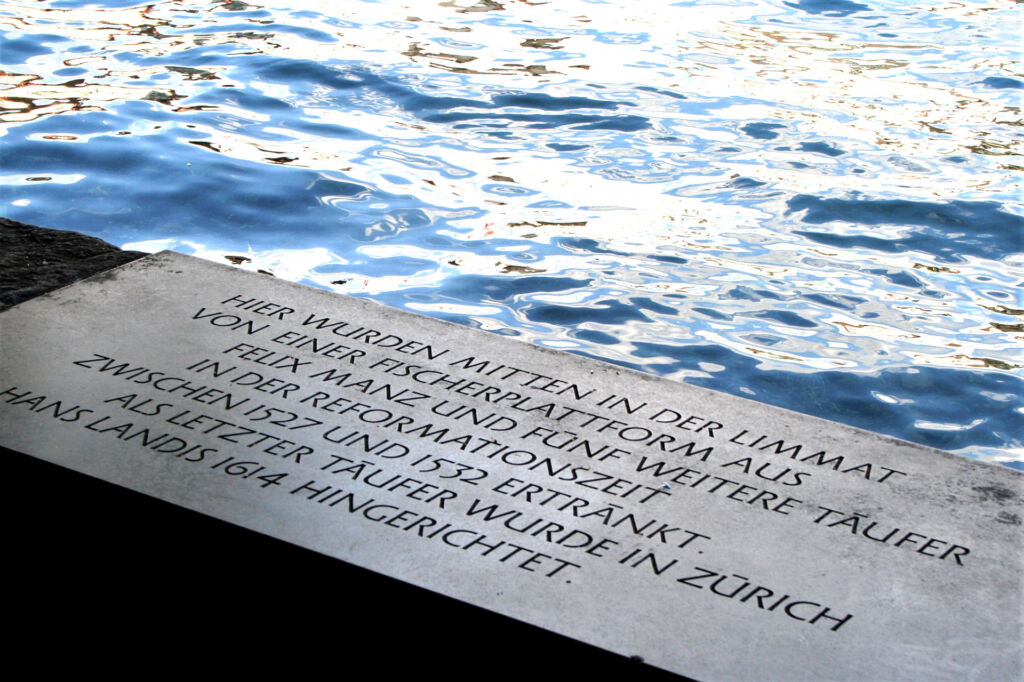
“Here in the middle of the River Limmat from a fishing platform were drowned Felix Manz and five other Anabaptists during the Reformation of 1527 to 1532. Hans Landis, the last Anabaptist, was executed in Zürich during 1614.”
4:38 Video
The Story of Felix Manz
Share this with Hastons or related family members who might be interested in the June 14-27, 2023 Hiestand-Haston European Heritage Tour.

19 – The Hiestand Brothers – Abraham and Daniel – Settle in Western North Carolina

19 - Abraham and Daniel Hiestand Settle in the "Carolinas"

Headed for "the Carolinas"
When the earliest post-Revolution settlers left their homes in places like Pennsylvania, Maryland, and Virginia and said, “We’re going to the Carolinas,” that did not necessarily mean they were going to the area enclosed in the current boundaries of North and South Carolina. There’s a good chance they may have been headed to Tennessee.*
The “Great Philadelphia Wagon Road” began in Philadelphia and ran westward through Lancaster, Pennsylvania across the Susquehanna River, through York, and Gettysburg, Pennsylvania. As the wagon road was running west it was gradually turning southward down into and through the Shenandoah Valley of western Maryland and Virginia. Near current-day Roanoke (then, called “Big Lick”) in southern Virginia, the road turned due south and entered North Carolina about 50 miles farther south. In the North Carolinian Piedmont, the road passed through the Moravian settlement of Salem, North Carolina, on past Salisbury and Charlotte, and then through South Carolina to Augusta, Georgia. As the Wagon Road passed Salem, it was about thirty miles west of where the city of Greensboro of Guilford County, North Carolina is today.
After Daniel Boone blazed a trail through upper-east Tennessee and into southern Kentucky, the “Wilderness Trail” became a well-traveled offshoot of the Great Wagon Road, leading pioneers into the great wilderness west of the Appalachian Mountains. “The opening of Tennessee and Kentucky deflected much of the former traffic of the Wagon Road”[i] as more and more settlers opted to go into the western wildernesses of North Carolina (Tennessee) and Virginia (Kentucky).
[i] Parke Rouse, Jr., From Philadelphia to the South: The Great Wagon Road. (Richmond, VA: The Dietz Press, 2001), 117.
Sometime prior to the autumn of 1783, Abraham and Daniel Hiestand must have announced to friends and family in Shenandoah County, Virginia that they were “going to the Carolinas,” because they were definitely preparing to go somewhere and both men showed up in western North Carolina shortly afterwards. When they came to the place where the Wilderness Road forked off of the Great Wagon Road, which way did they go? Did they both choose the same route? Or did they temporarily part ways?
Abraham had already purchased land in Tennessee, so he definitely had a reason to follow the Wilderness Road into the Washington District of Tennessee. But Daniel’s route is less certain. We will probably never know for sure, but there is some evidence that may suggest that Daniel continued to proceed south into the Piedmont of North Carolina and may have lingered there for a short time before crossing over the mountain into Tennessee.

Daniel's Three-Years Whereabouts
Daniel’s name and census-type information about his family appear on the 1783 Shenandoah County, Virginia tax list of Alexander Hite, but there is no specific date given for the tax listing census. Daniel may have lived in Shenandoah County until his father’s will was proven on August 28 of that year. But Daniel’s oldest brother Jacob sold (“released”) their father’s Fort Valley land—Daniel’s probable home place for ten years—on the very day their father’s will was proven in court. So, Daniel had already moved from Powell’s Fort Valley or was preparing to do so when Henrich Hiestand’s estate was settled.
The first date we know for sure that Daniel (Heston) was in the “Carolinas” was August 18, 1786 when he cast a vote in Jonesborough, Tennessee.[i] Where Daniel and his family were in the three years prior to August 1786 is unknown. He could have gone directly to Jonesborough or the area around there. Or he could have meandered in other parts of North Carolina before settling west of the Appalachian Range in eastern Tennessee. There are a few pieces of evidence that may warrant a hypothesis that he spent some time in Guilford County, North Carolina before moving westward over the mountain.
[i] Pollyanna Creekmore, “Documents Illustrative of Tennessee History,” Tennessee Ancestors, V, no. 2 (August 1989): 93.
Guilford County, North Carolina Connections

In a previous article, you saw that four men – “The Guilford County Four” – who were involved in the “Daniel Haston” Rev War military land grant, were from Guilford County, NC.
There were two other families who lived in Guilford County, NC who were known to have been connected to the Daniel Haston family. In a later article, you will learn about Philip & Mary McComisky Roddy AND James & Eleanor McComisky Ryan. The names “Roddy” and “McComiskey” were well-known to old-timer Haston researchers. But they searched in vain to figure out how these two surnames fit into the Daniel Haston family. It is just a guess on my part, but maybe Daniel spent a few months or a couple of years in Guilford County, NC before joining his brother, Abraham, over-the-mountain in Washington County, NC/TN. This Roddy-McComisky family and this Ryan-McComisky family also appear connected to the Hiestands/Hastons in Washington County–what is now Washington County, TN.
And in another later article, you will see that Daniel’s son, Joseph Haston, made a trip back to Guilford County, NC from Knoxville, TN in 1802, to settle an estate for Philip Roddy’s son, James Roddy. James Roddy, by the way, was (apparently) Daniel Haston’s son-in-law. But more on that story later also.
If you appreciated this article, please share it with others who might also enjoy it.

04 – The Anabaptist Cave – Täuferhöhle, Where Anabaptists Worshipped in Secret

04 - Täuferhöhle (Anabaptist Cave) - Secret Place for Worship
– Saturday, June 17, 2023, we will walk up the hill to see where Swiss Brethren (Anabaptists/Mennonites) met to worship in secret. –

The German word Täufer = “Baptist” in English, not Baptist as a denomination but Baptist as “one who baptizes.” In Switzerland, beginning in 1525 a Wiedertäufer (English = Anabaptist) was a person who rejected the infant baptism of the Catholic Church or the Reformed Church of Switzerland. They later became known as Mennonites.
To reject the baptism of the State Church, whether it be the Catholic or the Reformed Church, was so offensive to the State churches that people who followed the Anabaptist faith were hunted down and imprisoned, tortured, and even killed by drowning or burning at a stake. Later, lands of Anabaptists were confiscated by the State and these sincere Christ-followers were expelled from the country, often with nothing more than the clothes on their backs.
Were these people so bad that they deserved these kinds of persecutions? No – most of them were simple people who believed much like most evangelical Christians in America of our generation. And they were peace-loving pacifists who were trying to follow Jesus and love people like He loved them.
The Baptist World Alliance’s 2018 annual gathering started with Sunday morning worship in a cave outside Zurich, Switzerland, where early Anabaptists worshipped after fleeing persecution in Zurich in 1526. About 100 Baptists from around the world attended the service that included historical reflection, a homily on religious persecution today, songs, and times of prayer. This video features the two moments of singing. The first song is seen from just outside the cave looking in (with the sound of the water running that helped disguise the sounds of that early secret worship). The second song is seen from the back of the cave.
If you appreciated this article, please share it with others who might be interested.

18 – The Mysterious Daniel MG Hastings “Mortality List” Card
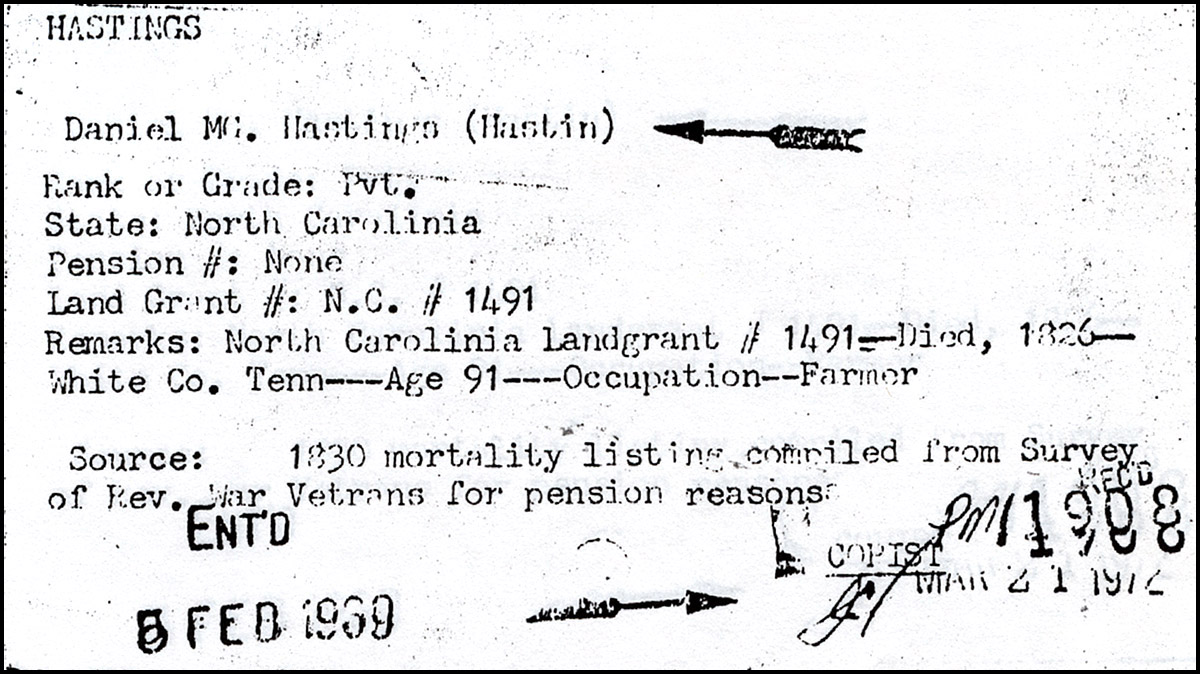
18 - The Mysterious Daniel MG. Hastings Mortality List Card

The "1830 Revolutionary War Mortality Listing" Card
In the early 1970s, Dwight Haston discovered the little card that you see pictured above. He found it in a research library in Arkansas. At that time, there was several members of the Daniel Haston family who were very actively researching the history of our family. Much of what we know about Daniel Haston was totally unknown at that time, approximately 50 years ago. So Haston researchers, at that time, thought the card was a treasure-find and understandably so.
As with the “Daniel Haston” survey warrant, this little document is also shrouded in a cloak of mysteries. There are several seemingly unanswerable questions related to this card. Some very diligent Haston family researchers, previous to my time, persistently pursued answers to these questions, but (as far as I can tell) came up empty every time.
If you haven’t seen a copy of this card, or heard about it, you probably will if you do much research on our Haston family. That’s why I think it is important that I tell you about it — some (1) observations that can be made from the card, especially in view of what we have learned over the past 50 years, (2) some of the attempts that have been made over the years to learn its source, and (3) questions and conclusions about the card from our current research perspective.
Observations from the Card
The spelling of Daniel’s surname—“Hastings” or “Hastin” is not unusual, but this indicates that the name was not taken from the “Daniel Haston” land grant documents. Does it mean the information was submitted by someone from a branch of the family that adopted the “Hastings” or “Hastin” surname spelling? David and Joseph, Daniel’s oldest two sons would not have spelled it this way. But some branches of the 2nd and 3rd generation families, especially Isaac’s family and some of Joseph’s descendants, adopted “Hastings” or “Hasting” or “Hastin.”
The “MG.” or “MC.” initials for a middle name do not fit any other previous document now known to have been associated with our Daniel. Based on a digitally enlarged copy of these letters, they appear to be M.G. At some point in the past, some earlier Haston family members got the idea that Daniel’s middle name was “Montgomery,” but that speculation was never proven. Now that we know Daniel was from a SWISS-German family, we can be sure that he was not given the name Montgomery.
The land grant that Thomas Archer received from Thomas Hays, who received the rights for the land from “Daniel Haston,” was number 1490, not 1491. This may be another indicator that the land grant was not the direct source of information for this card.
The age of Daniel at his time of death, as per this card, is most likely inaccurate. If he died in or about 1826 (which White County records support) and he was age 91 at the time of death, he would have been born in about 1735. As discussed in the previous chapter, circumstantial evidence strongly suggests that he was born in about 1750.
It appears that this card was “received” and date-stamped in 1908, “entered” and date-stamped on February 5 or 8, 1939, and stamped a third time on March 21, 1972 for some reason not indicated on the card. Perhaps this was the date that Dwight found it.
- The WPA (Works Progress Administration) program was very actively underway in Arkansas and elsewhere in 1939.[i] Perhaps WPA workers “entered” the information into some repository in February 1939.
[i] Sam Morgan, “Works Progress Administration (WPA),” The Encyclopedia of Arkansas History & Culture, accessed February 25, 2019, http://www.encyclopediaofarkansas.net/encyclopedia/entry-detail.aspx?entryID=2284.
- Apparently, the card was “active” in a library at least as late as March 21, 1972, shortly before Dave and Estelle Haston began trying to locate it. When did Dwight find the card? Was that on March 21, 1972 and it was stamped at the time he pulled it? October 8, 1973 is the date of a letter from Estelle to Dwight, asking about the location of the card.
- Note the hole for the card catalog rod at the bottom of the card, the common method used by pre-computerized library card catalogs for keeping cards intact in the drawer.
The initials at the bottom-right of the card—are those the initials of the “copist” [sic] or a person or people who date-stamped the card?
Brief History for a Later Search for the Card
Dwight Haston, from Spencer, Tennessee, was stationed at the Little Rock Air Force Base in Arkansas sometime in the late 1960s or very early in the 1970s. Dwight stated in written correspondence with Dave and Estelle Haston of Sparta, as well as to me personally nearly 30 years later, that he discovered this card at a “research library” in Little Rock. According to the “Source” entry on the card, supposedly the information on the card was taken from an 1830 mortality listing compiled from a “Survey of Rev. War Veterans for pension reasons.”
At the time Dwight discovered the card, he shared the information with Dave R. and Estelle Haston in Sparta, who were deeply involved in Daniel Haston family research. Dave and Estelle communicated what they learned with Colonel Howard Hasting, Sr., who was also a diligent Haston family researcher. Date and Estelle, as well as Colonel Hasting contacted some of the major libraries in Arkansas trying to locate the original card, but could not find any librarian who knew anything about it.
When I began researching the family, I also contacted the most probable libraries in Arkansas but–like Col. Hasting and Dave & Estelle–I could find no one knew anything about such a card. The Arkansas Genealogical Society told me the same thing. I was told that the card might possible be in the National Archives in Washington, but I hit a “brick wall” there too.
In Chapter 10 of the Heritage of Daniel Book I’m currently working on, I have included much documentation about these searches, including copies of some of the correspondence back and forth with Arkansas libraries and the National Archives.
My Findings and Questions
After twenty years of occasionally re-reading the correspondence related to this card from a previous generation of Haston family researchers and submitting my own queries to librarians and archivists in Arkansas, here are some of my own questions and thoughts regarding this mortality list card:
First: There was a very important 1832 Pension Act for Revolutionary Soldiers and their families. On June 7, 1832, the United States Federal Government enacted a service pension for all Revolutionary soldiers and sailors, continental and state. Also, widows and orphans became entitled to the balance of money due to a pensioner. This act “required pension applications to include the birthplace, age, and residence of the applicant and more.” Perhaps the information on the “Daniel MC. or MG. Hastings” card was collected in anticipation of the 1832 Pension Act, or research to use in persuading Congress to pass the act. But, if so, this still would not answer the some of our most important questions about the accuracy of the information on the card.
Second: Who provided the information on the card? I suppose we should tenuously assume that some family member living in or before 1830 provided this information—but who? David Haston, Daniel’s oldest son, would be the most likely person. Not only was he the oldest son, but he was living at the homeplace where Daniel lived prior to his death. But we know of no early member of the Daniel Haston family, including David Haston, who made mention of Daniel being a veteran of the Revolutionary War.
Third: Why the inaccuracies in the data on the card? It is true that various branches of Daniel’s descendants spelled his surname in different ways. So that could account for “Hastings” and “Hastin” on the card. But to say that he was 91 years old when he died in 1826, does not fit the facts that any good Haston researcher or early family member would have known about his life.
Fourth: Why was the card in a library in Arkansas, and not North Carolina or Tennessee? It might be noteworthy to mention that one branch of Daniel’s family moved to Yell County, Arkansas in about 1880 and they made a group decision to spell their surnames “Hasting.”[i] Perhaps some member from that branch was somewhat involved in submitting information for the card.
[i] Howard H. Hasting, Sr., “The Daniel Haston Family” (San Antonio: unpublished manuscript, last modified 1980), 3.
Fifth: As mentioned above, the “MC.” or “MG.” on the card raises some questions. Now (post-DNA testing) that we know our Daniel was a Swiss-German “Hiestand,” and not an English “Hasting” or “Hastings” or Scots-Irish “Haston” or “Hastin,” where did the middle initials come from and what do they represent? The very insertion of these middle initials is curious and raises concerns regarding the card’s accuracy and authenticity.
Sixth: Even though some of this information was not copied from the North Carolina bounty land warrant or survey, reference to the land grant associated with that warrant is mentioned on the card. But Daniel Haston did not receive land grant #1490 (or 1491 as wrongfully indicated on the card). Thomas Archer was the only person who received the land grant. The warrant was made out to “Daniel Haston” on September 29, 1785. The location was identified January 10, 1786 when Thomas Hays owned the rights to the warrant. And the tract was surveyed on July 23, 1791 upon the request of Thomas Archer. Only after the survey was returned to the Secretary of State’s office in Raleigh was a grant issued and assigned a grant number. And although we do not have a copy of the grant, according to the files we saw in a previous article, we know that the patent for the grant was issued to Thomas Archer. For the card to indicate that our Daniel Haston received North Carolina Land Grant #1491 (#1490) is a reason to question the authenticity of the card. Even if the “Daniel Haston” on warrant #2344 was our Daniel and even if he was a bona fide recipient of the North Carolina military bounty land warrant, neither he nor members of his immediate family would have known that Thomas Archer ended up settling the land and that the grant number would eventually be numbered 1490 (or 1491).
Seventh: Did someone counterfeit this card—create it to try to prove that our Daniel Haston did fight in the American Revolution? Someone who believed that Daniel was of English or Scots-Irish descent? If so, who? And when? And why? If the card is fake, the person who counterfeited it went to a lot of trouble to make it look authentic. And that would have been done prior to the computer era when digitalization began to make amateur counterfeiting easier and more convincing. Photoshop was not developed until 1987, at least a decade and a half before this card appeared to Haston researchers.
Eight: We are left with these questions:
- Was the card authentic and not created by some overly zealous Haston researcher?
- And where is the original card now?
Ninth: Even if the card is authentic, it does not establish solid evidence to prove that our Daniel was a Revolutionary War veteran. It would only prove that someone reported this information, partially based on the North Carolina bounty land warrant and survey, which may or may have been legitimately issued to our Daniel Haston.
My Final Conclusions
Dwight and I have discussed this and we agree on our now-perspective on the card:
A lot of Daniel’s descendants moved to Arkansas. Some of them remained there and others lived there for some months or years and move on, many of them to Texas. My guess is that this card was a summary of some Daniel Haston’s descendant’s research-related thinking in the late 1800s. We do not believe it was an official record, but only a personal genealogical record placed in a family file in one of the libraries in Arkansas. There are too many errors, based on what we now know, for the card to have been an official Revolutionary War record.
As many of you know, lots of libraries have cabinets full of “family files” where family members place copies of their genealogical documents. And if you have looked through any of these files, you know that you must be skeptical about what you read. In the late 1800s, it is understandable that the family member who created this card did not have access to much that we know over 100 years later. Probably, at some point after Dwight found the card, the library staff thought that these old files were of no value any more and trashed them.
It appears that the person who created the card had gathered the information recorded on the card from various sources–some from the Revolutionary War Land Grant (which he or she misidentified the warrant number), as well as hear-say sources from members of the family. The creator of the card may never have seen the land survey warrant personally.
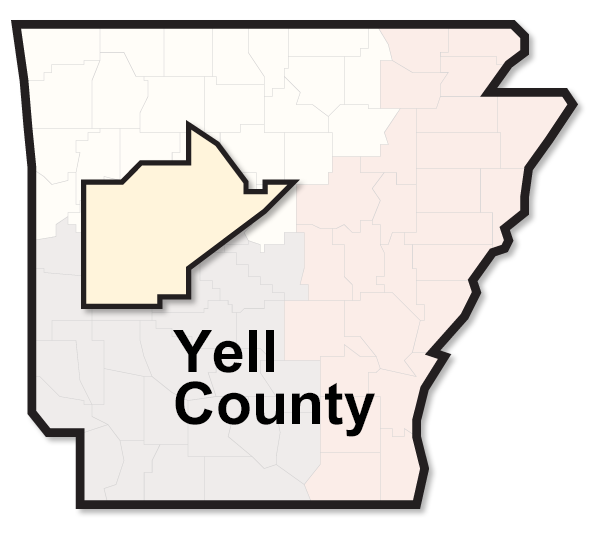
Since the creator spelled Daniel’s name “Hasting” or “Hastin,” I’m guessing that this was a member of Joseph Haston’s family who settled in Arkansas. We know, according to Col. Howard H. Hasting, Sr., one branch of Joseph’s family changed the spelling from Haston to Hasting while they were in Yell County, Arkansas.
If you appreciated this article, please share it with others who might also enjoy it.

Submit Name and USPS Address for Occasional Snail-Mailings

Building a USPS (Snail Mail) List for Occasional Mailings
Related to the History and Heritage of Daniel Haston & Haston Family Events

If your current surname (or the surname of a friend or relative who is related to the pioneer Daniel Haston family) is not spelled "Haston" or "Hastain" (example, you go by a married surname, or "Hasting," "Hastings," "Hastin," etc.), we need to add you or his/her to our USPS mailing list for occasional announcements.
If your current surname is spelled “Haston” or “Hastain” we probably have your US Post Office mailing address, but if you are not sure – please submit it and we will check to be sure we have it in our database.
Submit Information to Add People to Our USPS Mailing List
Please share this with other Daniel Haston descendants or related family members who might be interested in receiving occasional postal mailings.

DNA – Explained by Scientist and Genealogist Darvin Martin

DNA - An Introduction by Darvin Martin, Scientist & Genealogist

Summary of the Q&A in the Video
What are the main tests you can take to learn information about your background?
There are three types that can be tested, Martin says. There’s Y-DNA, a test for men, and corresponds to a surname. There’s mitochondrial DNA (mtDNA) that both women and men can test for, but is passed through the mother’s line. And there’s autosomal DNA, which looks at ethnic markers and tells you where your ancestors lived. It’s a combination of all of our DNA.
Note: My (Wayne Haston’s) DNA is in Darvin’s pool of Mennonite DNA study in FamilyTree DNA.
You (men) can add your FamilyTree Y-DNA too, if you want to.
What are the main things people are looking for?
People are looking for their ethnic background. If they’re willing to share aspects of their DNA, they can find matches to relatives who have matching segments of DNA. They can discover family matches even if their last names are different. Some tests trace ancestors back to ancient times.
What guarantee does anyone have that their DNA sample won’t be kept by the government?
Privacy is a big issue, Martin says. He separates companies like Ancestry.com, 23andMe and Family Tree DNA, from what he calls third-party sites. For the three companies, “If there’s a breach of privacy, it becomes a liability for those companies,” he says. “They have a lot of protections in place to have your DNA remain anonymous. It’s always a matter of, if you want to gather information, you’re going to have to give out information. There’s always a balance between what are you going to give out to receive back.
“Where the problem comes in is when you download your raw DNA data … and you send it to a third party site,” he says. “Often, there are no protections. This is what the police have used so far.”
Which of these tests does Martin prefer?
Martin’s favorite is Family Tree DNA because it was created to look at DNA as it relates to family history. The site 23andMe focuses more on the medical side and inherited characteristics, like hair color. For Ancestry.com, the DNA tests are secondary to the site’s genealogy resources.
How long do these tests last?
For years, especially if you keep them in a climate-controlled area. Don’t store them in your car or an attic.
If you appreciated this info, please share it with others who might be interested.

17b – Thomas Archer – the Eccentric Man from Guilford County, NC Who Ended Up with Warrant #2344
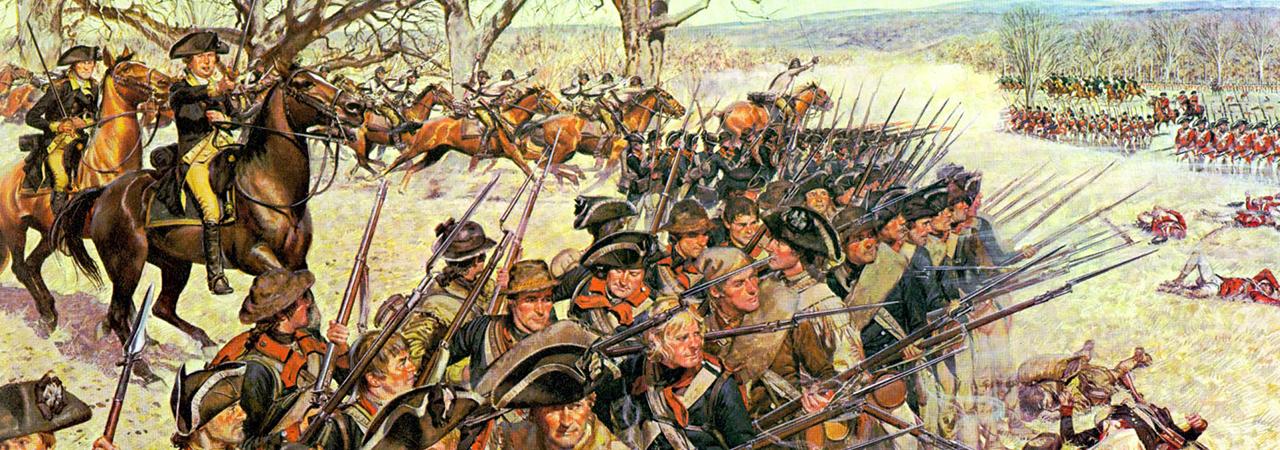
Thomas Archer - an Eccentric Man from Guilford County, NC
Who Ended Up With 640 Acres from Military Bounty Land Warrant #2344

This is #3 in a sequence of 3 articles. You should read the first two articles before reading this one.
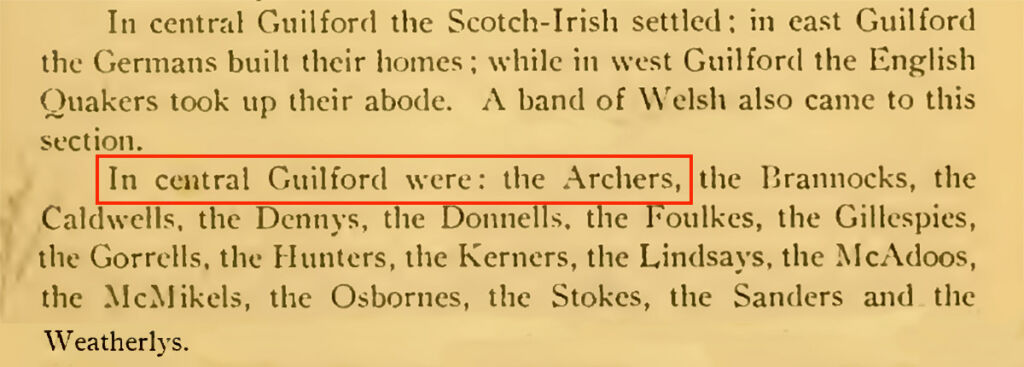
The area of the North Carolina Piedmont that became Guilford County was largely settled by three groups: “In central Guilford the Scotch-Irish [Presbyterians] settled; in east Guilford the Germans [Lutherans and Reformed mainly] built their homes; while in west Guilford the English Quakers took up their abode.”[i] The Archer family was a part of the Scots-Irish group, as were the McKemies and Hayses and many other families they closely associated with. James Archer was one of the early Scots-Irish settlers in the area, having settled on Horsepen Creek (a tributary of Reedy Fork) in or before 1765. One of his sons was Thomas.[ii]
[i] Sallie W. Stockard, “The History of Guilford County, North Carolina. (Knoxville, TN: Gaut-Ogden Company, 1902), 13.
[ii] S.M. Rankin, History of Buffalo Presbyterian Church and Her People. (1934; reprinted, New Delhi, India: Isha Books, 2013), 39.
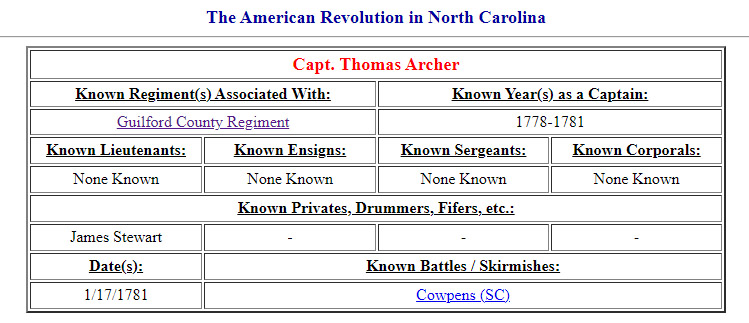
Leave It to Thomas Archer
Evidently, Thomas Archer was quite a character. An event that occurred in 1779 during the American Revolution says a lot about him. Guilford County was a hot bed of conflict between Whigs (American Patriots) and Tories (British Loyalists) during the war. Tories were especially numerous in the southern part of Guilford.[i] “As many citizens were British sympathizers as were Whig proponents.”[ii] It was neighbor against neighbor in many cases and, much like the Civil War nearly a century later, local hostilities were often heartless and brutal as the following incident illustrates:
[i] Rankin, 182.
[ii] Hughes, 105.
In the summer of 1779, two armed Tories, Hugh McPherson and one Campbell, from Moore County, appeared at William Brazelton’s door [in Guilford County], to surprise and capture Brazelton. Unknown to the intruders, Brazelton was not alone—a militia meeting was in progress in the house, with all of the company officers present as well as Brazelton and William Gipson of South Carolina. As he came through the door, McPherson was knocked to the floor by Risdon Moore, and both men were captured.
The two prisoners were marched to Guilford Courthouse. There the capturing force formed a courts martial of themselves and tried both men. McPherson was found guilty and executed by shooting. Campbell was found less guilty than McPherson and was subjected to different treatment. A spike was driven into a log, sharpened to a point. Then Campbell was stood upon the spike and rotated until the spike pierced his shoe and passed through his foot. Then he was removed from the spike and released. Campbell was rotated by Thomas Archer, a militiaman living near the courthouse.[i]
[i] Hughes, 39.
Thomas Archer - Local Mythical Hero
Thomas Archer was a local hero in Guilford County, seemingly of mythical proportions in his day. The following incident occurred about a month prior to the Battle of Guilford Courthouse which occurred on March 15, 1781.

Tarleton [British Colonel] says that, “on the road many skirmishes took place between the British and the American light troops;” and it is said by others that they seldom shot at each other except across a turn in the road or when crossing a stream of water, though they were often in sight and sometimes within a rifle shot. Occasionally, however, when the British were pressing too closely on them, they found it necessary to skirmish a little; and in such cases, as Williams [Benjamin Williams, colonel over the North Carolina Regiment], was on the retreat, he could generally select his own ground. On one occasion of this kind, according to favorable tradition, having drawn up the whole of his men in a position, he made show of fight, and appeared very determined on making a stout resistance. The British, thinking they had not force enough to encounter him, sent back for two pieces of artillery and a reinforcement of men. In the corps of Williams was a singular genius, by the name of Tom Archer, from the north-west corner of Guilford county, who, with some others, had probably joined them at Martinville [county seat of Guilford at that time], for the occasion. He was not remarkable for strength of intellect, but had some other qualities which admirably fitted him for the ever varying scenes of that arduous and perilous march. Rather above the medium height and well proportioned, bony, muscular and vigorous, he was always in his place and always ready for service. Though constantly on fatigue and exposed every hour to the most imminent dangers, he never complained or became discouraged. Frank and open hearted, with a good share of ready wit, and a good flow of spirits, he was the life of his comrades, and contributed not a little to their patient endurance of the toils and perils of the march. Inflexible in his purpose, when he thought he was right, and enthusiastic in the cause of freedom, rough in his manners, blunt in his language and never caring whether he “murdered the king’s English,” and made “Irish bulls,” [ludicrous and logically absurd statements] all the time or not, he was ever ready to be on the “forlorn hope,” [military situation where the risk is extremely high, essentially a suicide mission] or take his turn at any kind of service. If to the above characteristics we add a great catfish mouth [wide mouth with down-turned corners], a big stentorian [booming] voice, and a bushy head of hair that would hardly thank you for a hat, you have Tom Archer before you as large as life; and probably the reader will think with the writer that, in some situations at least, such a man would be a very desirable friend; but, at all times a most undesirable enemy; or in other words, that he would, if not wronged or provoked in any way, be as clever a fellow as could be found in his sphere of life, ready to divide his last ration with a comrade or risk his life for a friend, but would “fight his weight in wild cats” before he would suffer any man or any set of men to trample on his rights. Hunting had been his delight from the time he was old enough to “draw a bead;” and, with his fine rifle, which he always carried and always kept in good order, he hardly ever missed his aim at any distance within two hundred yards.
When the artillery was brought up to its position in the road, Archer stepped out into the middle of the road, directly in front of the guns, and hailed them at the top of his big, strong voice, “Hallow, there—Mister, I wish you would take that ugly thing out of the road, or it may cause some trouble yet before all is over;” and then turning his head over his shoulder, said, to an officer standing by, “Captain, may I shoot that cussed rascal? for he has no business there, no how.”
“No, said the captain, not yet—wait till they are ready to apply the match; for we want to detain them as long as we can.”
The enemy, of course, if they heard him at all, paid no attention, as they would take him for a drunken fool or some crack-brained mortal; but while the preparations were making—Williams bringing up and marshalling his men, and the British doing the same—Archer stepped to the side of the road and stood there leaning against a tree, resting his gun with the butt on the ground, and in perfect silence, as if in a “brown study,” [lost in thought or day dreaming] or anticipating the pleasure of the feat which he expected to perform, and keeping his eye steadily fixed on that “ugly thing,” in the road. He had full confidence both in the gun and in himself; and having now a good opportunity as he thought, he was anxious to make another trial. Fear, was a word which had no place in his vocabulary, and he was probably never more composed in his life, but waited for leave to shoot, with as much impatience as he ever waited for a fine buck to come along when pursued by the hounds. The time was short—a very few minutes; and when he thought they were nearly ready to apply the match, he stepped out into the middle of the road and hailed them again. “Hallo, there—Mister, I say you had better take that thing out of the road, or I’ll be hanged if I don’t shoot some of you.” Then turning to the officer, said as before, “Captain, may I shoot that cussed rascal now; for tellin’ don’t do him one bit o’ good?”
“Yes,” said the captain, “and as quick as you can, for we have no time to lose.”
Having got permission, he clapped his rifle up against the side of the tree and taking sure aim with the quickness of an experienced hunter, and at the distance of about two hundred yards, when the gun cracked, a “red coat” fell. Then vaulting into the saddle, they all dashed off at full speed; and being favored by a hollow or a turn in the road, they had just time to get beyond the reach of the grape shot before the “big gun,” was fired. By this maneuvering on the part of Williams the enemy were probably detained an hour or two, which was no small advantage to the retreating army.
The above anecdote I had, some years ago, from what I consider good authority, and the character or Archer is well known in this community. There are many yet living [in 1856] who, when they were young, were well acquainted with him and they all, when asked, gave me the same account. One old gentleman replied to my inquiry with a laugh, that he had just sense enough to be “fool hardy;” but then he went on to give me his character more seriously, which agreed perfectly with that given by many others. He had considerable military spirit and got some office, that of captain, or one of lower grade; but it was found that, with a courage that feared nothing, he lacked discretion.[i]
[i] Rev. Eli W. Caruthers, The Old North State in 176, Volumes I and II with INDEX. (1854 and 1856; reprinted, Greensboro, NC: The Guilford County Genealogical Society, 1985), 119-120.
Thomas Archer’s lack of discretion sometimes got him into trouble throughout his life, but it seems that he remained popular and well-liked in spite of his indiscretions.
During the 1780s and 1790s, Thomas Archer was mentioned as a defendant or plaintiff in Guilford County Court cases, approximately eighteen times. Three of those were “State vs. Thomas Archer” cases. The verdicts are often difficult to understand in the court abstracts, but it appears that he was guilty about two-thirds of the time he was involved in court cases.[i] For example, on May 17, 1784 “Thomas Archer who was Indicted for Retailing Liquors came into Court and submitted and was fined 10 [shillings].”[ii] A century or so later he would have been called a bootlegger. But, at that time, the stigma of bootlegging liquor was not nearly as scandalous as it came to be in later years. According to the Fred Hughes map of early Guilford County, Thomas Archer was a tavern keeper in the county.[iii]
[i] Greensboro Public Library, “Guilford Court Records, 1781-1790,” Colonial Court Records of Guilford County, accessed March 17, 2019, https://library.greensboro-nc.gov/home/showdocument?id=5580.
Greensboro Public Library, “Guilford Court Records, 1791-1800,” Colonial Court Records of Guilford County, accessed March 17, 2019, https://library.greensboro-nc.gov/home/showdocument?id=5579.
[ii] “Guilford Court Records, 1781-1790,” 102.
[iii] Fred Hughes, Guilford County, N.C. Map. (Jamestown, NC: printed by author, 1988), lower-right corner.
As was often the case in those days, men who were found guilty in court from time to time were also chosen to serve in very legitimate civil roles. Thomas Archer was often a juryman in the county court, a juror in the Salisbury Superior Court, a bondsman for defendants in court cases, an overseer of road projects, a county patroller in Captain McAdams District, and a tax collector in Mr. Caldwell’s District. The person who created endnotes for the 1780s Guilford County Court abstracts, noted this about Thomas Archer: “[This was] the same Thomas Archer who ran the pin through the foot of a Tory prisoner at Guilford Courthouse. A violent and sadistic, tax assessor what could be better.”[i] With a reputation like his, who would dare fail to pay their taxes!
[i] “Guilford Court Records, 1781-1790,” 320, 323.
Elizabeth Archer, sister of Thomas, married John Hamilton on October 25, 1774. John Hamilton* was a prominent civic leader serving in a variety of roles—County Commissioner, Justice of the Peace, Clerk of the Court, and Sheriff for Guilford County, a member of the North Carolina’s House of Commons, as well as a tavern owner near the courthouse in Martinsville. Apparently, John Hamilton used his offices for personal gain. He “had 33 land transactions before 1800, including eight grants of 1800 acres, plus half-interest in five others, for a total granted acreage of 1800 acres, plus land purchased from individuals.”[i] In August 1786, Thomas Archer brought a lawsuit against his highly-positioned brother-in-law and won the case.
[i] Hughes, 6-7.
The will of James Archer, father of Thomas, was proved in the August 1799 session of the Guilford County Court. Thomas received 70 shillings, which his father said was “besides what he has already had as part of my estate.”[i] James Archer and his wife, parents of Thomas, are buried in lost graves at the Buffalo Presbyterian Church, which they helped to found—the church that no doubt Thomas Archer grew up attending.[ii]
[i] “James Archer,” North Carolina Will Abstracts, 1799-1885—Guilford, Warren, Orange, Mecklenberg, Edgecomb Counties. (Will Book A-1, dated January 2, 1799; proved August Court 1799).
[ii] Raymond Dufau Donnell, Buffalo Presbyterian Church and Cemetery, Greensboro, North Carolina. (reprint, Forgotten Books, 2018), 72.
Perhaps it was the death of his father that precipitated Thomas’s move to Tennessee, to the land granted to “Daniel Haston” by warrant #2344 which he, Thomas Archer, bought from Thomas Hays. Thomas Archer died in 1818 in (what was then) Dickson County, Tennessee. As we saw in the previous chapter, Archer’s Grant #1490 land is now in the southeastern corner of Houston County, which was created partially out of Dickson County in 1871.
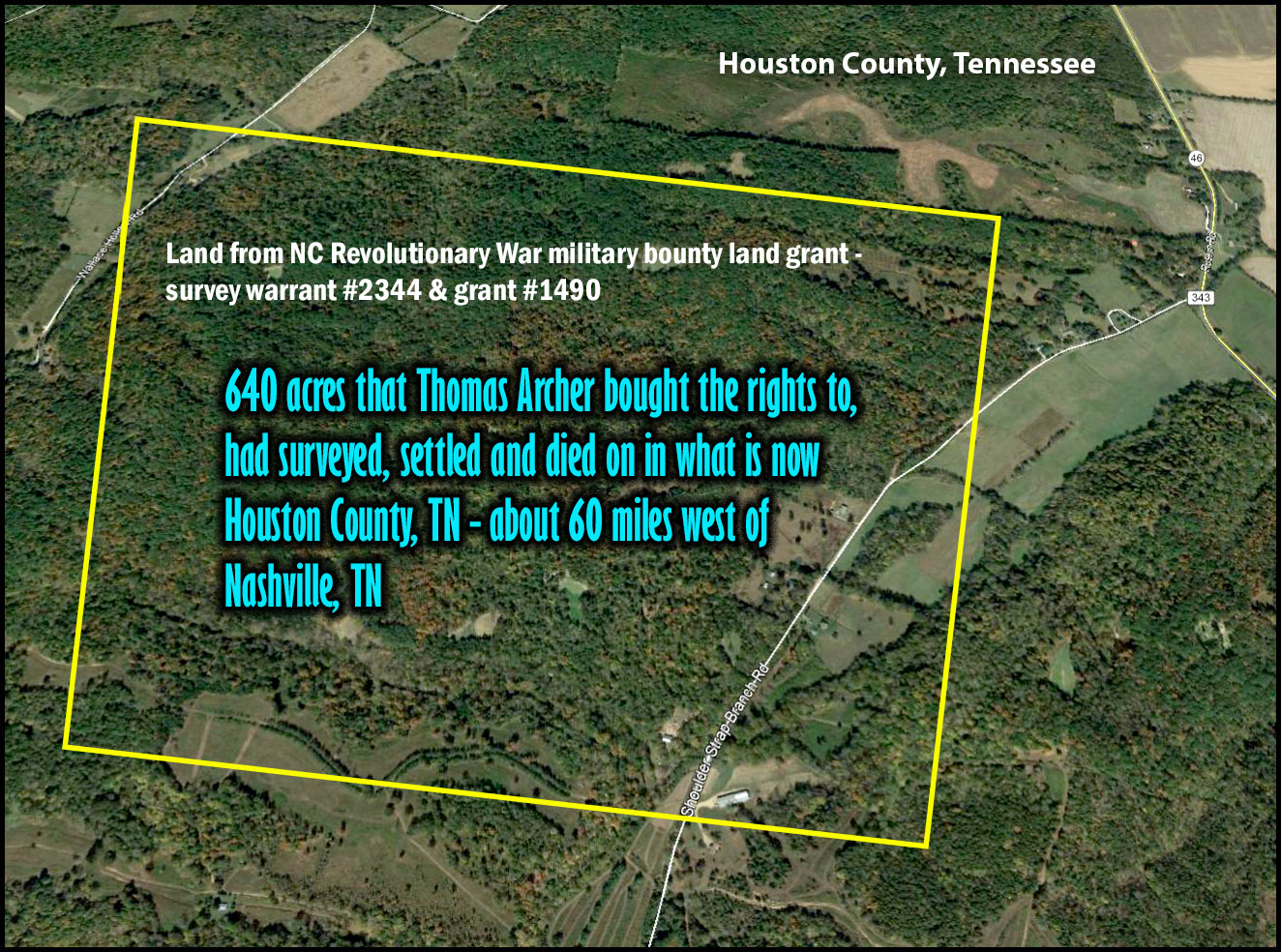
Questions and Hypotheses
Here is a question that haunts me: If the “Daniel Haston” warrant was a fraud and if Daniel’s name was assigned to it without him knowing about it, where did William Faircloth (or Thomas Hays) come up with the name “Daniel Haston”—a family name generally unknown in that area of North Carolina at that time? I can only speculate some possible answers to that question. Perhaps…
1. There was no fraud in the issue and assignment of warrant #2344 and “Daniel Haston” (our Daniel or another man by that name) did serve in the war, receive the warrant, and transfer it to Thomas Hays—everything was the way it would appear to have been. We examined the pros and cons of this possibility in a previous article. Or perhaps…
—–
2. William Faircloth, the former lieutenant in the 10th North Carolina Regiment, or Thomas Hays (or someone else at the Fairfield plantation) just created the name “Daniel Haston” out of thin air. The fact that the “Haston” family name in that area, at that time, was extremely rare if existent at all would make that unlikely. Or perhaps…
—–
3. One of these men knew, or knew of, Daniel Haston and simply stole his name without him ever knowing about it. If that was their mode of operation, they probably would have tried to pick someone whom they knew would never discover that his name was used fraudulently. And an English-illiterate German Virginian, just temporarily sojourning in Guilford County before moving into the trans-Appalachian wilderness, would have fit the bill nicely.
The third hypothesis may be the most plausible answer to my haunting question. And there is possible evidence to suggest that Daniel might have lingered for a short while in the Guilford County area prior to moving on to Tennessee—long enough to have become acquainted with someone who could have suggested his name to William Faircloth.
If you appreciated this article, please share it with others who might also enjoy it.

17a – The “Guilford County Four” and Rev War Land Grant Proceedings at Fairfield Plantation

17a - The "Guilford County Four"
And the Epicenter of 1785 Land Fraud - James Glasgow's "Fairfield" Plantation

This is #2 in a sequence of 3 articles. You should read the first article before reading this one.
The Epicenter of Revolutionary War Land Fraud
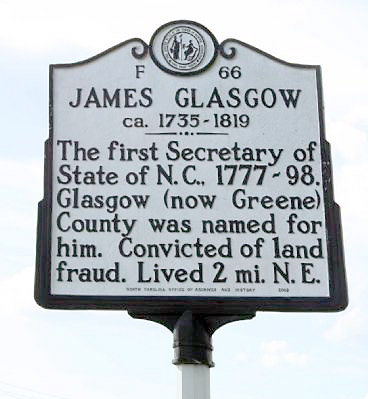
A good man turned bad. How many times have we heard stories such as this? Because of his heroic service in the Revolutionary War, James Glasgow was elected as the first Secretary of State in North Carolina in 1777. He served in that position for more than 20 years, until it was discovered that he and his cronies were using their positions and political powers to defraud hundreds (perhaps thousands) of Revolutionary War veterans. And the State of North Carolina was robbed of hundreds of thousands of acres and millions of dollars through corrupt assignments of Revolutionary War bounty land grants. Eventually, Glasgow was convicted in the Glasgow Land Fraud Case.
In 1765, James Glasgow acquired a plantation on Contentnea Creek known as “Fairfield” as a gift from his father-in-law. The Fairfield Plantation, located in what was then Dobbs County, NC, became a hub of Glasgow’s illegal assignments of Revolutionary War military bounty-land survey warrants.
Warrant #2344 Connections in Guilford County, NC
Four men whose names appear on the backside of the “Daniel Haston” military bounty land document (Survey Warrant #2344) were known to be residents of Guilford County, North Carolina—Thomas Hays, James Hays, Robert McKemie, and Thomas Archer. This is the original record of Thomas Hays transferring Warrant #2344 to Thomas Archer, with Robert McKemie and James Hays as witnesses.
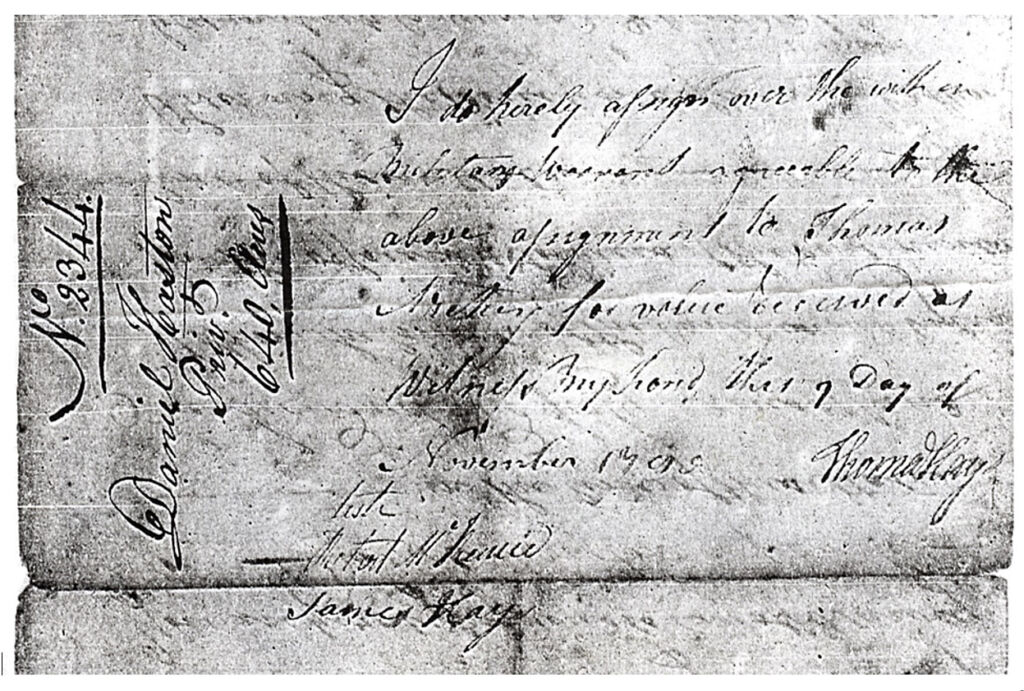
I call them the “Guilford County Four.”
I conducted extensive research trying to find some kind of connection between our Daniel Haston and any one of these four men. But I found no evidence that would suggest our Daniel was in any way connected to one or more of them.
Thomas Hays
The “Daniel Haston” warrant for survey #2344 was issued on September 29, 1785 by Willoughby Williams and was assigned to Thomas Hays the following day, September 30, 1785. Ostensibly, “Daniel Haston” transferred the rights for 640 acres of military bounty land to Thomas Hays.
From studying the North Carolina military bounty land records, it appears that Thomas Hays was a small-scale speculator in the military land grants. In addition to the rights to the two warrants he purchased and transferred to Thomas Archer, it seems that he purchased and kept the rights for 640-acre tracts from the heir of Abraham Henderson, the heir of Micajah Smith, and from Joshua Murry.
On August 20, 1792 Hays sold 150 acres on the waters of Haw River,[i] and died in that same year. Even though Thomas Hays was involved in purchasing and selling rights to land in the Military Reservation in north central Tennessee, he continued to live in Guilford County and died there.
[i] Pruitt, Abstracts of Deeds – Guilford County, NC, Books 3, 4, 5, & 6, [page] 163.
I asked Dr. A.B. Pruitt as to whether or not it was likely that Thomas Hays was aware that the “Daniel Haston” warrant might be fraudulent. Dr. Pruitt responded: “Thomas Hays probably didn’t worry if his actions were legal or not. Most people involved in Tennessee land were busy doing their own thing, and they didn’t know details about what others were doing, but they did know some folks were obtaining more land than they had.”[i]
[i] Pruitt, email to Wayne Haston, March 8, 2019.
Who is Dr. A.B. Pruitt?
Dr. Albert Bruce Pruitt is the most prolific producer of historical resources on North Carolina and Tennessee of our generation. He is probably THE leading authority on the Glasgow Land Frauds–the fraudulent activity by some of North Carolina’s leaders of the late 1780s and early 1790s to enrich themselves by making false claims regarding military bounty land warrants for thousands of acres in upper Middle Tennessee (the Military Reservation).
I did not find any court records or other documents that would indicate that Thomas Hays was (or was not), in general, an unscrupulous man.
James Hays
Robert McKemie and James Hays were the two witnesses to the assignment of warrant #2344 from “Daniel Haston” to Thomas Hays. Both were closely related to Thomas Hays and both lived in Guilford County. According to a court record for an administration of the estate of Thomas Hays in 1792, James Hays, Sr. was a brother of Thomas Hays.
In May of 1786, James Hays (Sr.) was found guilty by a jury in an assault case (The State vs. James Hays) and fined by the court.[i] In those days, assault cases often were for relatively minor offenses, but we have no details regarding this case. In 1792, James Hays was living on the land of “Thomas, Deceased.” Was this James, Sr. or James, Jr.?
[i] Greensboro Public Library, “Guilford Court Records, 1781-1790,” Colonial Court Records of Guilford County, accessed March 17, 2019, https://library.greensboro-nc.gov/home/showdocument?id=5580, original page 205.
Robert McKemie
Robert McKemie* was born in Philadelphia and christened in a Presbyterian Church. He was a Justice of the Peace as early as 1776 in Guilford County and continued in that office for more than twenty years.[i] He owned land adjacent to James Hays on the waters of the Haw River,[ii] but purchased a lot in the village of Martinsville, where the Guilford County Courthouse was located from 1774 to 1808. It appears that his Justice of the Peace district was the area of Guilford County north of the Haw River. Robert’s sister, Elizabeth, married James Hays on November 26, 1776, so James Hays and the Justice of Peace for his area were brothers-in-law. But on February 20, 1795, Robert McKemie was a plaintiff in the case, Robert McKemie vs. John and James Hays.[iii]
[i] Fred Hughes, Guilford County, NC – A Map Supplement. (Jamestown, NC: The Custom House, 1988), 122.
[ii] Guilford County Deed Book 1, 511, 512.
[iii] Guilford County Deed Book 2, 293.
Suspicious Scenarios
There were some very suspicious circumstances surrounding the #2344 “Daniel Haston” military land warrant. In addition to what was presented in the earlier chapter, consider this set of scenarios:
- On September 29, 1785, on behalf of “Daniel Haston,” William Faircloth received warrant #2344 from Willoughby Williams (Deputy Secretary of State) at Secretary of State James Glasgow’s “Fairfield” plantation. Faircloth then supposedly gave the warrant to “Daniel Haston,” the supposed rightful owner who transferred it to Thomas Hays.
- James Glasgow (ca. 1735-1819), born in Maryland, in 1765 acquired a plantation on Contentnea Creek (northeast of Kinston, NC) known as “Fairfield” as a gift from his father-in-law. Fairfield, Glasgow’s plantation, was in the old (now non-existent) Dobbs County.
- Where Faircloth received the warrant for “Daniel Haston” on September 29 was approximately 160 miles from (south east of) where Thomas Hays lived in Guilford County.
- The warrant was (allegedly) assigned by “Daniel Haston” to Thomas Hays on September 30, just one day after Faircloth received it at Glasgow’s plantation in then-Dobbs County.
- Did Faircloth carry the warrant from Dobbs County to Guilford County in one day in order to deliver it to “Daniel Haston,” who assigned it to Thomas Hays on the same day? Or were “Daniel Haston” and Thomas Hays both at the Fairfield plantation where Faircloth received it from Willoughby Williams and handed it over to “Daniel Haston,” who assigned it to Thomas Hays at that place?
- If Thomas Hays and “Daniel Haston” were in Dobbs County where the warrant was received by Faircloth and assigned by “Haston” to Hays, then James Hays and Robert McKemie must have also been there with them in order to witness the transfer.
Obviously, no one traveled 160 miles in one day at that time. The hypothetical scenario of “Daniel Haston,” Thomas Hays, James Hays, and Robert McKemie all being in Dobbs County at the same time would have been possible, but only if “all of the planets lined up” perfectly.
Thomas Archer - What about him?
Although not a part of the original “Guilford County Three,” Thomas Archer became involved later. Archer, also a Guilford County, NC citizen, was the man who ended up with Warrant #2343 and the land in Middle Tennessee that went with it. IF Thomas Hays, James Hays, and Robert McKemie were knowingly involved in any wrongdoings in the “Daniel Haston” Warrant #2344, Thomas Archer was far enough removed from the original transfer from “Daniel Haston” to Thomas Hays that he may not have known anything about what happened at the Fairfield Plantation.
Thomas Hays was such a colorful person that I’ve just got to tell you more about him!
If you appreciated this article, please share it with others who might also enjoy it.

17 – The “Daniel Haston” Revolutionary War Land Grant

The "Daniel Haston" Rev War Land Grant
Legal or Fraudulent?

640 acres in Houston County, TN (west of Nashville) were granted to Thomas Archer, based on Revolutionary War Land Grant #2344. The right to the land was originally issued to a "Daniel Haston." But was the name Daniel Haston just used by NC Secretary of State James Glasgow and his corrupt cronies to sell military bounty land for their own profit? It was discovered that this was a common modus operandi they used in their thieving get-rich scheme that became the focus of the Glasgow Land Fraud Case.
When I began to research the history of the Daniel Haston family in 1999, family tradition was generally committed, and tenaciously so, to the idea that Daniel Haston was a Revolutionary War veteran. However, unlike many family stories about early ancestors, this belief was not based solely on family lore passed down orally through several generations from some unknown original source. It was grounded largely in two documents that on the surface appear to clearly validate the family legend of Daniel’s service in a North Carolina Revolutionary War regiment.
If this topic was being tried in a courtroom, no doubt the first article of evidence would be a survey warrant issued to “Daniel Haston” on September 29, 1785 for a North Carolina military bounty land grant.[i] To gain access to this document is a simple matter of making a request to the State Archives in Raleigh, North Carolina. But there is much more to this document, and the survey that accompanies it in the file, than meets the eye. To understand the full story behind the warrant and survey, and its implications for those of us who claim Daniel Haston as our ancestor, requires some serious additional research as you will see below.
[i] “Thomas Archer, No. 2344, Secretary of State Land Grant Warrant and Survey, S.108.388; Tennessee County, TN.” (Raleigh, NC: North Carolina State Archives).
North Carolina’s Military Bounty Land Grants
In 1780, the North Carolina Assembly passed an act to boost enlistment in the Continental Line of its Revolutionary War army by promising land grants within the state as payment and reward (“bounty”) for military service. That initiative was refined in 1782 and 1783. Here’s the essence of the 1783 law:[i]
[i] A.B. Pruitt, Tennessee Land Entries Military Bounty Land Martin Armstrong’s Office, Part 1, Location book (#3138-4839). (n.p.: printed by the author, 1996), iv-vii.
This law allowed a soldier to receive a “warrant of survey” from North Carolina’s Secretary of State. The survey warrant was a document that permitted a Revolutionary War veteran to locate land and have it surveyed in order to receive a land grant from the state of North Carolina. The amount of land to be surveyed and granted was based on the soldier’s rank and length of service in the North Carolina Continental Army (not including militia duty). Privates who served in the army for seven years (the length of the war) were promised grants of 640 acres; higher ranks were allotted more land. The Secretary of State and his deputies were responsible to verify that the applicants were qualified—had actually mustered and served the required length of time in the North Carolina Army during the Revolutionary War, without deserting.
Problem: James Glasgow, NC Secretary of State and his deputies turned out to be corrupt. The fraud was uncovered after a few years and the result was the Glasgow Land Grant Fraud Case that embarrassed and angered officials in the State of North Carolina.
If a soldier desired, he could endorse the back of the survey in order to sell and assign his rights to anyone, with only a single witness. There was no law that required the Secretary to review the warrant or the survey before the grant was issued and the Land Office in Nashville was not required to review the exchange of rights. Because many of the soldiers “were very poor, ignorant, and credulous, and easily imposed upon by land speculators,”[i] a lot of greedy men took advantage of them, their families, and the state of North Carolina.
[i] Albert Lincoln Bramlett, “North Carolina’s Western Lands.” (PhD dissertation, North Carolina University, 1928), 114.
Because of the absence of reviews and oversight in key steps in the process, the integrity of the entire system was largely dependent on the first step in Secretary Glasgow’s office, verifying if applicants were qualified to receive a warrant of survey. Officials in the North Carolina government later came to regret their failure to build more accountability into this process. Fifteen years after North Carolina legislators enacted the law, they rued their neglect to supervise the system more carefully.
Problem: James Glasgow, NC Secretary of State and his deputies turned out to be corrupt.
Military Bounty Land Warrant #2344 and Grant #1490
A “warrant” was a certificate that permitted the recipient to locate and survey land. A “grant” was the final document that actually transferred the land to the grantee.

At the State Archives of North Carolina in Raleigh, there are a couple of military bounty land documents (a warrant for a survey and the survey itself) filed under the name of “Thomas Archer, Assignee of Daniel Haston.” On September 29, 1785, a man named “Daniel Haston,” or someone using that name, received a private’s warrant of survey for 640 acres as compensation for Revolutionary War service. The documents are filed in the name of Thomas Archer because Archer was the man who eventually owned the rights to the warrant, located the land, requested the survey, received the grant, and settled on the granted tract.
The original recipient of the warrant (whoever that was) almost immediately transferred the warrant to Thomas Hays (probably “Thomas Hays” of Guilford County, North Carolina). Hays was assigned the rights to the warrant on September 30, 1785, the day after the warrant was issued under the authority of the North Carolina Secretary of State’s office.
This transfer of a warrant was not at all unusual. Many of the recipients of warrants for North Carolina military land grants sold them because the difficulty of occupying these granted lands was incredibly challenging at that time. Thomas Hays later sold the warrant to Thomas Archer of Guilford County, North Carolina, on November 7, 1785.
The "Daniel Haston" Warrant #2344 in the Fraud Investigation
On September 29, 1785, 37 (thirty-seven!) warrants for military bounty land surveys were delivered to William Faircloth by the Deputy Secretary of State, Willoughby Williams.[i] This means that Faircloth, who had been a lieutenant in the 10th Regiment of the North Carolina Continental Army, was supposedly representing and vouching for 37 Revolutionary War warrantees in order to receive their warrants and deliver them to the rightful owners. But more than half (19 of the 37) of these military land warrants were “mentioned” in the Glasgow Land Fraud case, meaning there were indications of fraudulent activity related to these 19 warrants. With almost all of these fraudulent warrants, the Commissioners noted that the “soldier didn’t muster” (or deserted) and the “warrant assignment forged.”
[i] Pruitt, Tennessee Land Entries, Part 3, 538-543.
On the same day, Faircloth also presented 14 non-military survey warrants from the James Armstrong office for men who were purported to have been soldiers and all 14 of those were suspected to be fraudulent. So, 65% (33 of 51) warrants delivered to William Faircloth on that one day were suspected to be illegal.
The #2344 “Daniel Haston” military warrant was one of the warrants noted as “not mentioned in Glasgow land fraud.”
Sept. 29, 1785 warrant 2344 Pvt. Daniel Haston 640 ac delivered to Wm Faircloth, 84 months; file #36; grant to Thos Archer; [for grant see file #201 in Tennessee Co; MARS 12.14.19.200 warrant not mentioned in Glasgow land fraud].[i] [Italics and bold type added by this author.]
[i] Pruitt, Tennessee Land Entries, Part 3, 542.
While this is certainly not bad news, it is not necessarily good news for those of us who would like to think that our ancestor was a Revolutionary War soldier. Remember that the Commissioners did not have time to deeply investigate all 5,000+ warrants. To this point, Dr. Pruitt stated:
It is highly probable that in some instances the Commissioners may have considered and reported against some warrants as fraudulent, which in fact were fair, and against some persons as concerned in the fabrication of illegitimate assignment, who in truth were not concerned; it is certain also that they have passed over many warrants as fair, which were not fair, and left unnoticed and unimpeached many persons who had been employed in cheating the soldier and the State. These errors have not crept in from inattention, but from their not possessing the means to description or detection in some ample manner as was necessary for the discharge of so difficult a duty.[i]
[i] Pruitt, Glasgow Land Fraud Papers, Part 1 & Index, 52.
So, for the “Daniel Haston” warrant to have not been mentioned in the fraud case, does not prove that the warrant was legitimate and that a man by that name had served in the North Carolina army during the war.
When I first saw the “warrant not mentioned in Glasgow land fraud” comment, with regard to the “Daniel Haston” warrant, I was greatly relieved, thinking, “That settles it; Daniel Haston truly was a Revolutionary War veteran.” But deeper investigation into the warrant and the circumstances behind it have raised several questions and concerns in my mind about the validity of the warrant.
Questions and Concerns
1. How could our Daniel Haston have served in the war for seven years and his name not appear on any muster list or pay roll list?
There is now no known-to-me (or known to Dr. A.B. Pruitt and Russell Koonts who searched all of the known available records) muster list or pay roll or pay voucher that mentions Daniel Haston’s name as a soldier in the Revolutionary War. His name as a Revolutionary War soldier only appears with reference to this one document
2. How could he have served for seven years in a North Carolina regiment, with what we know about his residence and family in the Northern Neck of Virginia during at least part of that time, as was presented in the previous chapter?
Where Daniel lived in Virginia to the northern border of North Carolina is approximately 200 miles, three and a half hours of travel by car today, but probably a week on horseback in Daniel’s time. That’s just to the northern border of North Carolina. And what about the fact that at least two children (probably three) were born to Daniel Haston in the very midst of the war, David on May 6, 1777 and Joseph on January 9, 1780? Another child appeared in the family census record prior to 1783, when the war ended.
3. How can we trust any warrant assigned to William Faircloth?
William Faircloth, from Dobbs County, North Carolina, was an officer (briefly) in the inglorious Tenth Regiment of the North Carolina Army, but only for 131 days (January 20, 1778 through June 1, 1778).[i] He certainly was not a significant officer in the unit. Led by Colonel Abraham Sheppard (father-in-law of James Glasgow), the Tenth Regiment was “more of a hindrance than any great aid to the war effort.”[ii] “Colonel Sheppard and the officers under his command “disobeyed orders on frivolous and insufficient reasons.”[iii] Colonel Sheppard’s paymaster, Benjamin Sheppard, and quartermaster, Alexander Outlaw, were declared unworthy of holding their offices because of suspicion of counterfeiting.[v]
[i] Gertrude Sloan Hay, Roster of Soldiers from North Carolina in the American Revolution. (Baltimore, MD: Genealogical Publishing, 1984), 22, 123.
[ii] Hugh F. Rankin, The North Carolina Continentals. (Chapel Hill, NC: The University of North Carolina Press, 1971), 138.
[iii] Rankin, 134.
[iv] Rankin, 130.
[v] Rankin, 133.
“After the close of the war, some of the colonels of the regiments failed to return muster rolls and records. The law provided, however, that the soldiers be granted lands on certificates from the colonels of their regiments, certifying that they had served at least two years.” William Faircloth was never a colonel, only a Lieutenant and he was only in the army from January 20, 1778 through June 1, 1778. How could he have vouched for Daniel Haston as serving in the war for at least two years?[i]
[i] Bramlett, 96.
Ten years prior to the discovery of fraud in the distribution of military bounty land, William Faircloth was indicted for defrauding the state by falsely procuring pay from the accounts of soldiers.[i] A special court was established in January 1787 at Warrenton, North Carolina to try Faircloth and several others accused of pay fraud. Many of these same men would later be found to have been involved using similar methods of fraud in the Glasgow Land Fraud case.
[i] Russell Scott Koonts, “The Warrenton Army Frauds” (unpublished document, 1997), 11.
If 65% of the survey warrants presented to William Faircloth on September 29, 1785—same place, same day, by the same man—were illegally issued or reassigned, there is a definite cause for concern that the “Daniel Haston” warrant (as well as some others “not mentioned”) might also have been wrongfully issued. One of the “mentioned in the Glasgow land fraud” warrants (warrant #2349) issued on that day was assigned to Thomas Hays, the same man who acquired the rights to the “Daniel Haston” #2344 warrant and later sold it to Thomas Archer. Guess who purchased the rights to warrant #2349? Thomas Archer!
September 29, 1785 warrant 2349 [no names] heirs of Pvt. Richard Rose 640 ac delivered to Wm Faircloth; 84 months; file and grant [blank]*; [warrant in Tennessee Revolutionary War warrants (roll 4), assigned Apr. 30, 1785 by Sampson Rose (or Rece), to Martin Armstrong (John Smith witness) and assigned Nov. 7, 1785 by Thomas Hays to Thomas Archer (Robert McKennie and James Hays witness); grant #1957 from state of Tennessee included, entry #1259 dated Jan. 5, 1808, grant to John Davidson for 340 ac in Stewart Co on Trace Cr of Tennessee R; warrant mentioned in part 3 p. 61 of Glasgow land fraud; soldier didn’t muster; warrant taken to Tennessee in 1801 by William Christmas.[i]
[i] Pruitt, Tennessee Land Entries, Part 3, 542-534.
So, William Faircloth did not assume the post-war task of distributing warrants with the credibility of a highly efficient and trustworthy officer who had an outstanding record of military service. And September 29, 1785 was just one day in the post-Revolution life of William Faircloth; he was involved with numerous other ‘bad” warrants at other times.
Lt. William Faircloth was never brought to trial for his participation in the land fraud cases. Why? Because he had died in prison, for his central role in ripping off soldiers in pay fraud. Nearly all of the pay accounts that Faircloth had been involved in were found to be fraudulent. He had withdrawn £6,935.8.11 (pounds, shillings, pence) from the treasury.[i] Sixty-five percent of the “soldiers” for whom pay had been drawn by the total group of pay fraud perpetrators were for men whose names never appeared on any muster roll. So, forgery of names was common. Less than 5% of the accounts were deemed to be good and accurate.[ii] The name of “Daniel Haston” was not mentioned in any way in the Warrenton Pay Fraud investigations.
[i] Koonts, “The Warrenton Army Frauds,” 18.
[ii] Koonts, “The Warrenton Army Frauds,” 29-30.
4. How does the “Daniel Haston” assignment signature (to Thomas Hays) compare with a known-to-be-genuine signature of Daniel Hiestand/Haston?
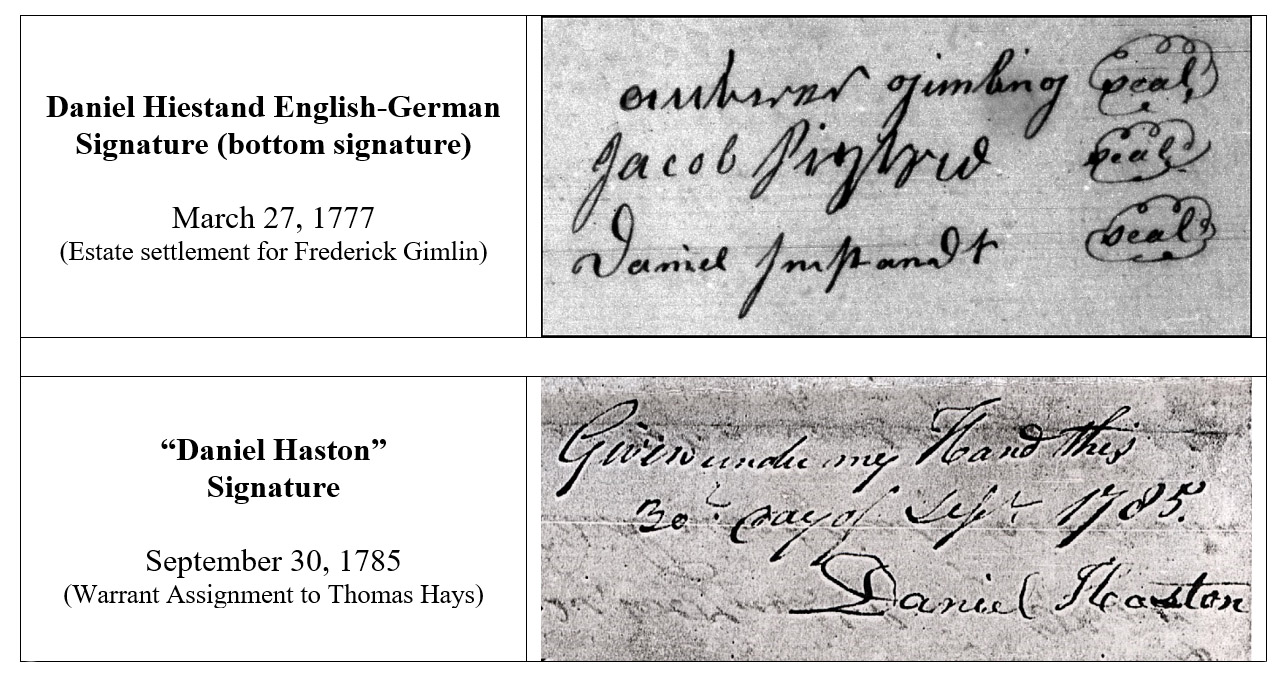
The "Much More" That Could Be Said
Summarizing an entire chapter (Chapter 10 in my in-progress book) of 50+ pages into one blog article requires that I have to be selective in what I include. And in the case of this article, the story continues through the first 12 or so pages of Chapter 11.
Chapter 11 provides background on some of the main characters in the story: Thomas Hays, his brother James Hays, Robert McKemie (brother-in-law of James Hays), and Thomas Archer. All four of these men were from Guilford County, NC–think Greensboro, NC.
For years, earlier Haston researchers assumed that “Fairfield,” where the assignment of Warrant #2344 and subsequent transfer happened was a little place in Hyde County, NC very near the Atlantic Coast. But actually “Fairfield” was the plantation of Secretary of State, James Glasgow, in then-Dobbs County, NC. When you do some detective work concerning (1) the distance between Guilford County and old-Dobbs County and (2) some of the dates related to the issue and transfer of Warrant #2344, some serious questions arise about the legitimacy of this “Daniel Haston” Warrant #2344.
I’ve added a “bonus” article that address some of the Chapter 10 and Chapter 11 content which I referred to in the previous paragraphs.
If you appreciated this article, please share it with others who might also enjoy it.

03 – Hiestand Bakery in Zurich, Switzerland

03 - Hiestand Bakery Bistro and Shop in Zurich, Switzerland

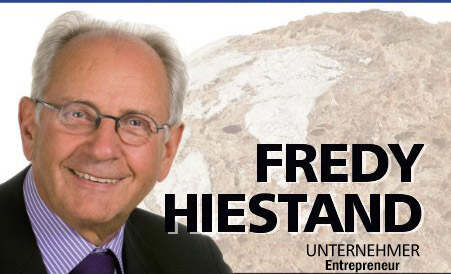
Alfred (Fredy) Hiestand comes from Hiestand family, which is the honorable bakery brand in Europe. He brought advanced production machinery and equipment, technology, management team and his product concept. In the year 1967, Alfred Hiestand established his first bakery in a disused laundry with simple equipment. The small bakery in Zurich, Switzerland evolved over the next 46 years into one of the leading providers of high quality frozen bakery products. Hiestand products are provided to the markets worldwide, Hiestand family opened up the factories in Germany, Switzerland, Malaysia, China, etc. Meanwhile, Alfred Hiestand is respected as “The king of croissant” in Europe. The huge R&D team of Hiestand based in both Germany and Switzerland master the advantage deep frozen technology. Source
Making cookies and pastries must be in Alfred Hiestand’s blood!
From even earlier than the old Roman Empire, forerunners of a Richterswil Wilderness Trust enshrined nicknames for each of the clans that belonged to it, primarily as a way to distinguish them from others of the same name not considered close kin. At the beginning of the 19th Century, a list transcribed by the trust recorded a “Cookiebaker” Hiestand family, the “Blueberry” Bachmanns, and eleven subclans of the prolific “Abraham,” “Childrobber,” “Drummer,” “Fiddler” and “Fleabitten” Stricklers. Some of the names and the families they described had died out by the end of the 20th Century; but some new nicknames had to be coined as families grew and split. -Ross Baughman






Hiestand Bakery Facebook Page


